Step back in time with a captivating blend of style inspired by the 14th and 15th centuries. Medieval revivalism embraces the elegance of corsets, flowing gowns, and lush layered textures, creating outfits that make you feel like you’ve walked out of a historical tale. This fashion trend draws on the rich aesthetics of the past while offering a playful twist for modern wearers. Whether for a themed event or everyday wear, these outfits bring a charming touch to your wardrobe.
Layered Textures in Medieval Fashion
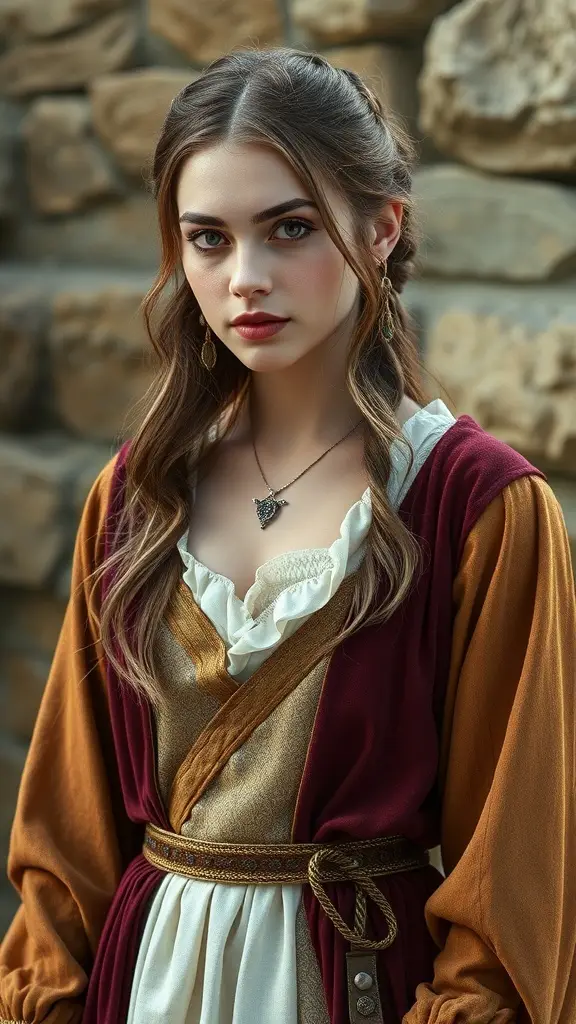
Layered textures played a significant role in medieval fashion, showcasing the craftsmanship and artistry of the time. The image captures a collection of outfits that embody this style beautifully. Each piece features rich fabrics and intricate details that reflect the essence of Medieval Revivalism.
The garments displayed include a vibrant orange cloak, a deep burgundy robe, and a flowing green gown. These layers not only add depth to the outfits but also highlight the importance of color and texture in medieval attire. The use of contrasting materials creates a visual feast, inviting the eye to explore every detail.
Notice how the flowing gowns and structured pieces work together. The layered approach allows for movement and elegance, reminiscent of the 14th and 15th centuries. Each outfit tells a story, evoking a sense of history while remaining stylish and modern.
Chemises and Undergarments
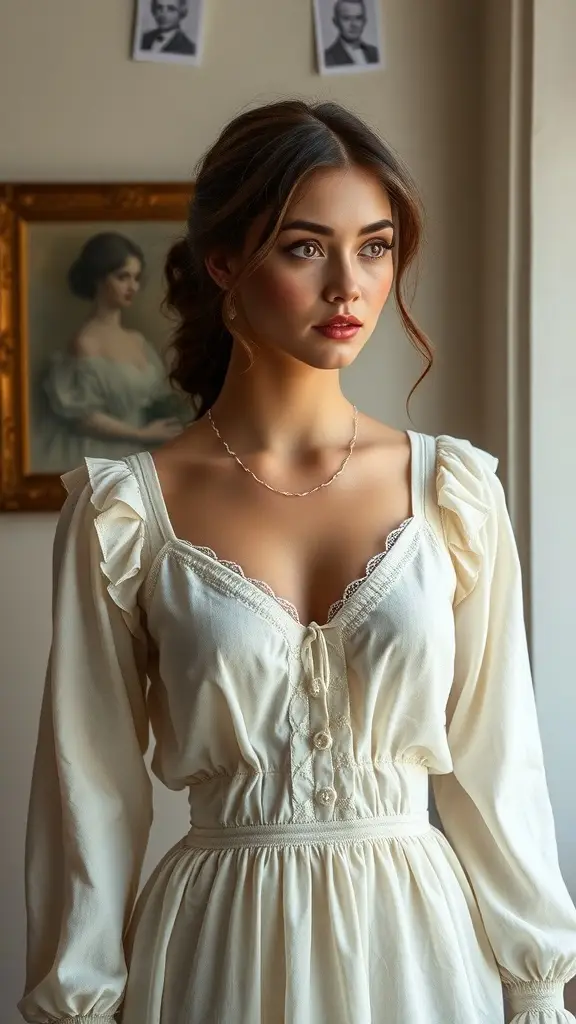
In the realm of Medieval Revivalism, chemises and undergarments play a key role in recreating the elegance of the 14th and 15th centuries. These pieces are often the foundation of any historical outfit, providing comfort and a touch of authenticity.
The image showcases a lovely white chemise, characterized by its soft fabric and flowing design. The delicate ruffles at the sleeves add a charming detail, reminiscent of the styles worn during the medieval period. Such garments were typically worn beneath gowns, serving both practical and aesthetic purposes.
Traditionally, chemises were made from linen or cotton, allowing for breathability. They helped to protect outer garments from body oils and sweat, extending the life of more elaborate outfits. In today’s fashion, they are often embraced for their romantic look and versatility.
Incorporating a chemise into your wardrobe can elevate your medieval-inspired attire. Whether worn alone or layered, it adds a layer of texture and softness. This piece is essential for anyone looking to embrace the beauty of Medieval Revivalism.
Elegant Corsetry Techniques
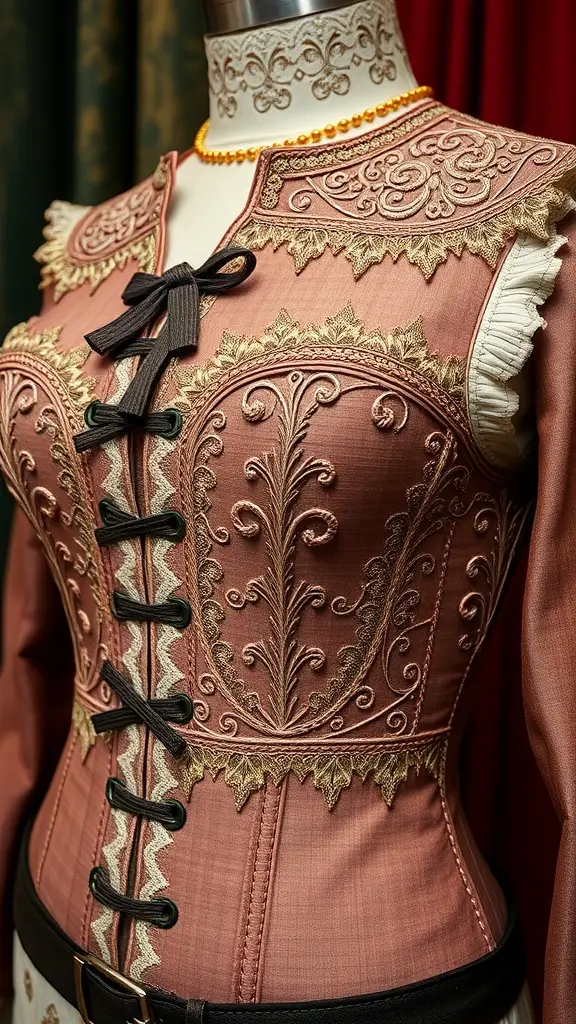
Corsets have made a strong comeback in the realm of Medieval Revivalism, bringing a touch of history into modern fashion. The image showcases a beautifully crafted corset, adorned with intricate embroidery and elegant detailing. The soft pink fabric contrasts beautifully with the gold accents, making it a standout piece.
The design features a structured silhouette that emphasizes the waist, a hallmark of corsetry from the 14th and 15th centuries. The lacing at the front not only serves a functional purpose but also adds to the visual appeal. This technique allows for a customizable fit, ensuring comfort while maintaining that classic hourglass shape.
Layering textures is key in achieving that authentic medieval look. The corset pairs well with flowing gowns, creating a harmonious blend of structure and softness. This combination not only highlights the craftsmanship of the corset but also enhances the overall elegance of the outfit.
Historical Footwear Styles
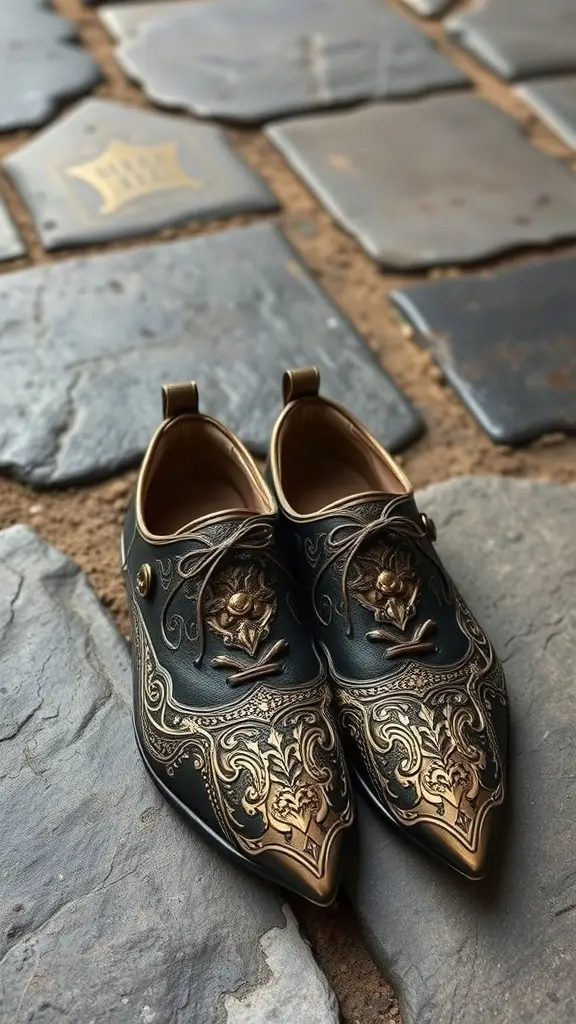
When we think of Medieval Revivalism, footwear often gets overlooked. Yet, shoes from the 14th and 15th centuries were not just practical; they were also a statement of style. The image showcases a pair of beautifully crafted shoes that reflect this era’s elegance.
These shoes feature intricate designs and a pointed toe, which were popular in medieval times. The combination of dark leather and gold detailing adds a touch of luxury. Such footwear would have been worn by those who wanted to display their status and taste.
In the past, shoes were often hand-made, making each pair unique. The craftsmanship seen in this image highlights the attention to detail that was essential during this period. Today, these styles inspire modern fashion, blending historical elements with contemporary design.
As we embrace Medieval Revivalism, it’s fascinating to see how these historical footwear styles continue to influence our wardrobe choices. Whether for a themed event or everyday wear, these shoes remind us of a time when fashion was an art form.
The Influence of Royalty on Fashion
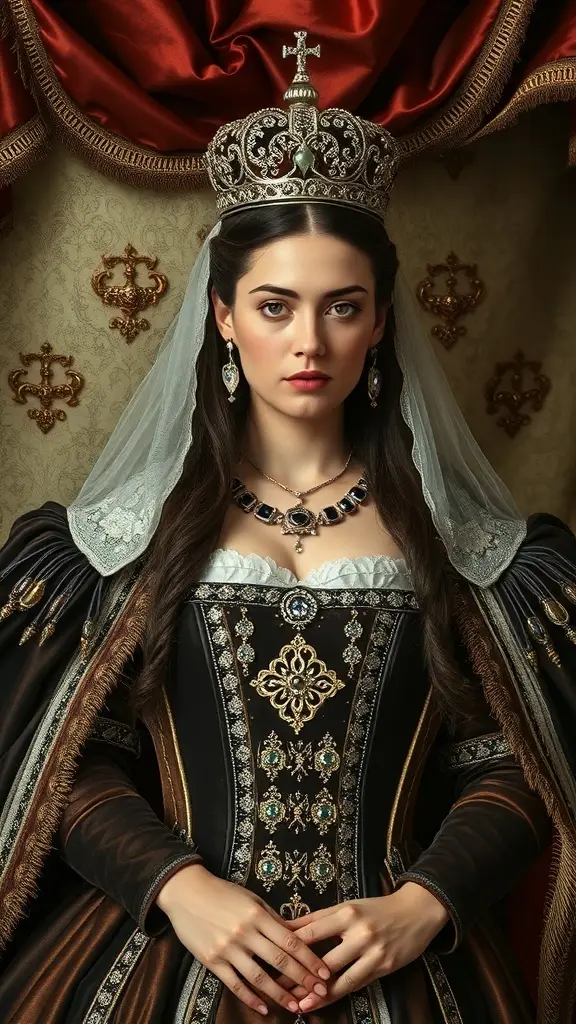
Royalty has always played a significant role in shaping fashion trends, especially during the medieval period. The image showcases a stunning outfit that reflects the opulence and grandeur of the 14th and 15th centuries. The flowing gown, adorned with intricate patterns and rich colors, captures the essence of Medieval Revivalism.
The corset emphasizes the waist, creating a silhouette that was highly sought after by noblewomen. The layered textures add depth and richness to the ensemble, making it a perfect representation of royal attire. The crown and jewelry further enhance the regal look, signaling status and wealth.
Fashion during this time was not just about aesthetics; it was a statement of power and influence. The materials used, often luxurious fabrics like silk and velvet, were reserved for those of high rank. This image beautifully illustrates how the styles of royalty continue to inspire modern fashion, merging historical elements with contemporary designs.
Rich Color Palettes of the 14th Century
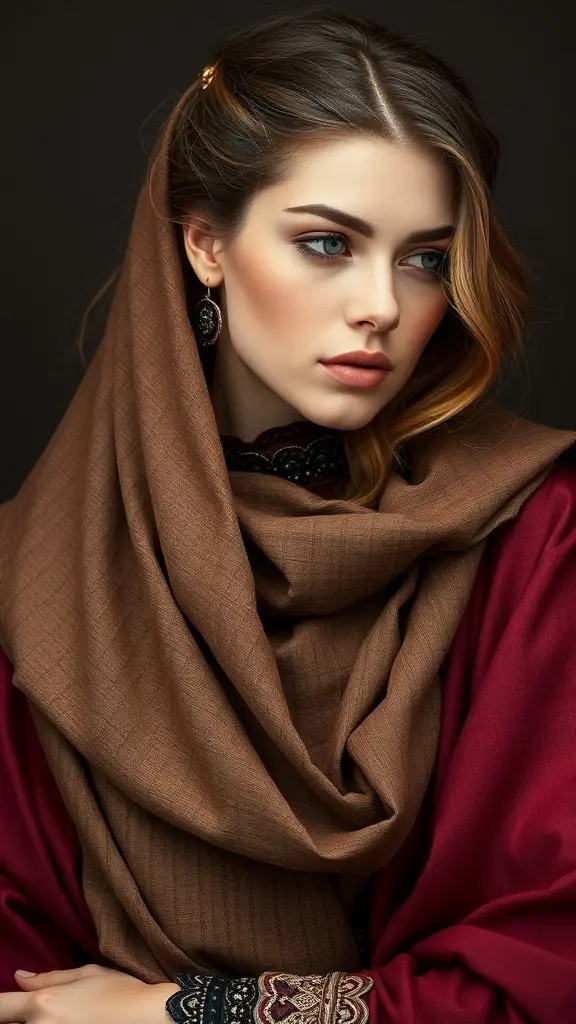
The 14th century was a time of vibrant colors and luxurious fabrics. Outfits from this era often featured rich hues that captured the eye and reflected the status of the wearer. In the image, we see a beautiful arrangement of fabrics in deep green, burgundy, and warm gold. These colors were popular during the medieval period and are making a comeback in modern fashion through Medieval Revivalism.
Each color tells a story. The deep green symbolizes nature and renewal, while burgundy represents wealth and power. The golden tones add a touch of warmth and elegance, reminiscent of the opulence of the time. Layering these colors creates a stunning visual effect, perfect for flowing gowns and structured corsets.
Incorporating these rich palettes into contemporary outfits can evoke the charm of the 14th century. Whether it’s a dress for a special occasion or a casual ensemble, these colors can bring a sense of history and style to modern wardrobes. Embracing Medieval Revivalism allows us to celebrate the artistry of the past while making it our own.
Flowing Gowns with Historical Patterns
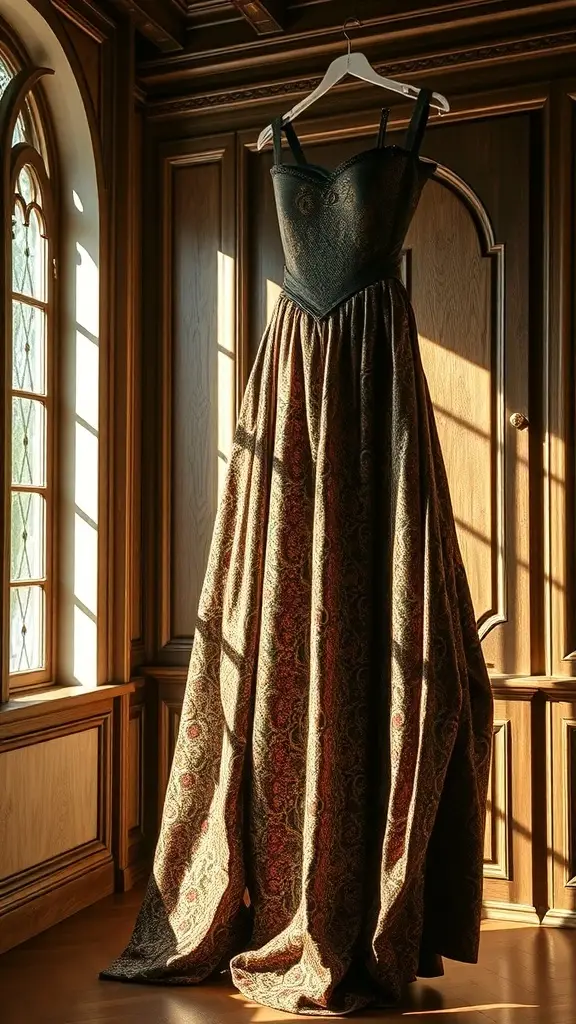
Flowing gowns are a hallmark of Medieval Revivalism, bringing a touch of history into modern fashion. The gown in the image showcases a beautiful blend of textures and patterns that echo the styles of the 14th and 15th centuries.
The bodice features a structured corset design, which was popular during medieval times. This style not only enhances the silhouette but also adds an air of elegance. The intricate patterns on the skirt are reminiscent of the rich fabrics used in that era, often adorned with elaborate motifs.
The gown’s flowing fabric creates a graceful drape, allowing for movement that feels both regal and comfortable. Such designs invite wearers to step into a world where history and modernity meet, making them perfect for themed events or even everyday wear with a twist.
Incorporating these historical elements into contemporary outfits allows for a unique expression of style. Whether you’re attending a renaissance fair or simply want to add a touch of medieval charm to your wardrobe, flowing gowns like this one are a fantastic choice.
Accessories that Define the Era
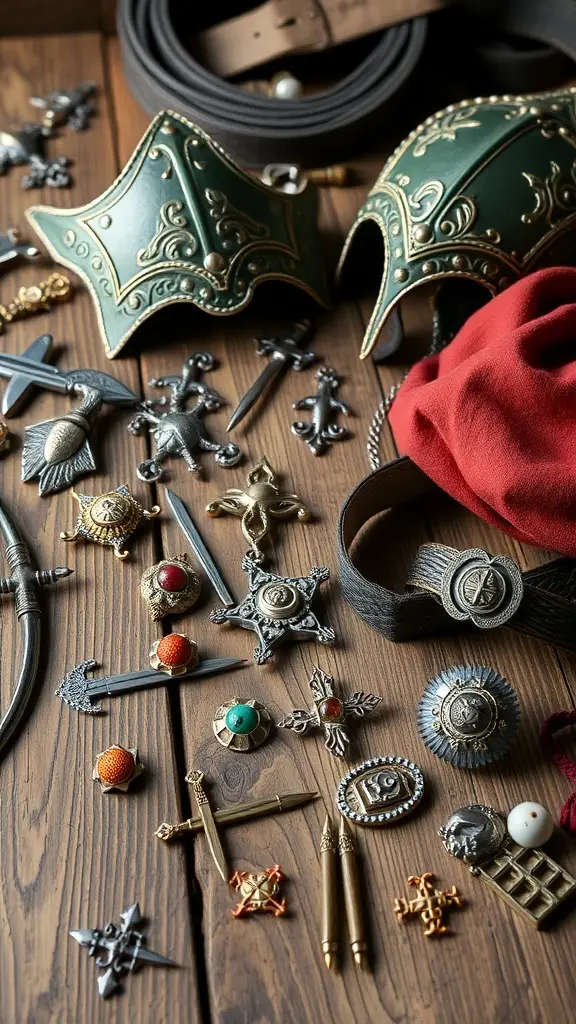
When we think of Medieval Revivalism, accessories play a key role in bringing the past to life. The image showcases a variety of items that reflect the style and craftsmanship of the 14th and 15th centuries. From ornate helmets to intricate brooches, each piece tells a story.
The green leather armor pieces stand out, hinting at the importance of protection and status in medieval times. These accessories were not just functional; they were also a way to express individuality and wealth. The detailed designs on the armor suggest a rich history and a connection to the artistry of the era.
Alongside the armor, we see an array of decorative pins and small swords. These items were often used to fasten clothing or as symbols of allegiance. The vibrant colors and varied materials highlight the creativity of medieval artisans. Each accessory adds depth to the overall look, making it feel authentic and immersive.
The belts and other elements in the image further enhance the layered textures typical of medieval outfits. They serve both practical and aesthetic purposes, tying the entire ensemble together. In Medieval Revivalism, these accessories are essential for anyone looking to capture the spirit of the time.
Layering Techniques for Warmth and Style
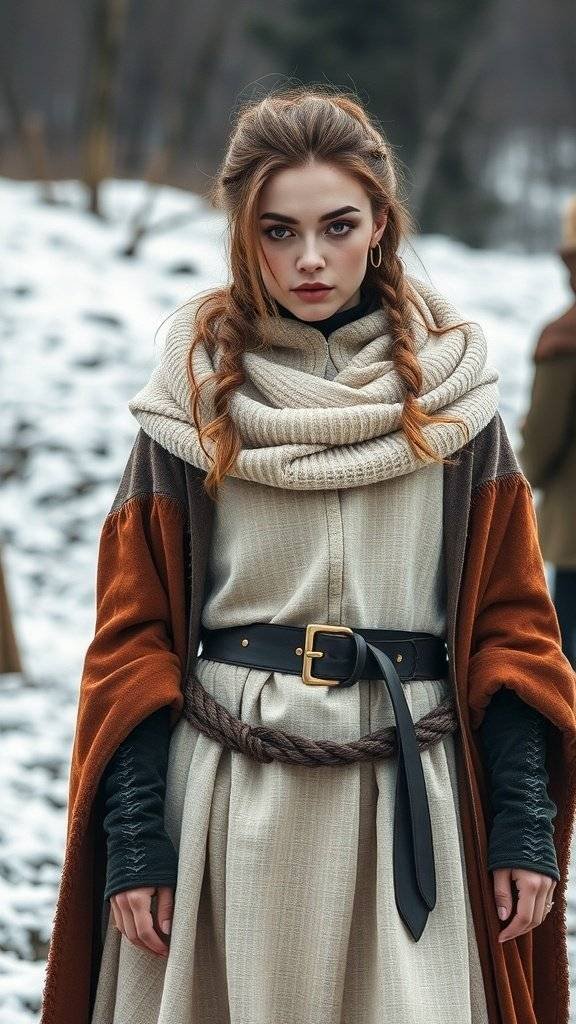
In the realm of Medieval Revivalism, layering is key to achieving both warmth and style. The image showcases a stunning outfit that perfectly embodies this concept. The model wears a flowing gown, complemented by a cozy, oversized scarf that adds texture and depth.
The combination of fabrics creates a rich visual appeal. The gown’s base is simple yet elegant, while the outer layers bring in a touch of drama. The use of a belt cinches the waist, providing shape and structure to the flowing silhouette.
Colors play an important role too. The warm tones of the outer layers contrast beautifully with the lighter gown, making the outfit pop. This thoughtful layering not only keeps the wearer warm but also showcases the creativity of Medieval-inspired fashion.
In colder months, layering becomes essential. The choice of materials, like wool and linen, ensures comfort while still looking chic. This approach allows for versatility, letting one adapt to different settings while staying true to the medieval aesthetic.
The Role of Color in Status Representation
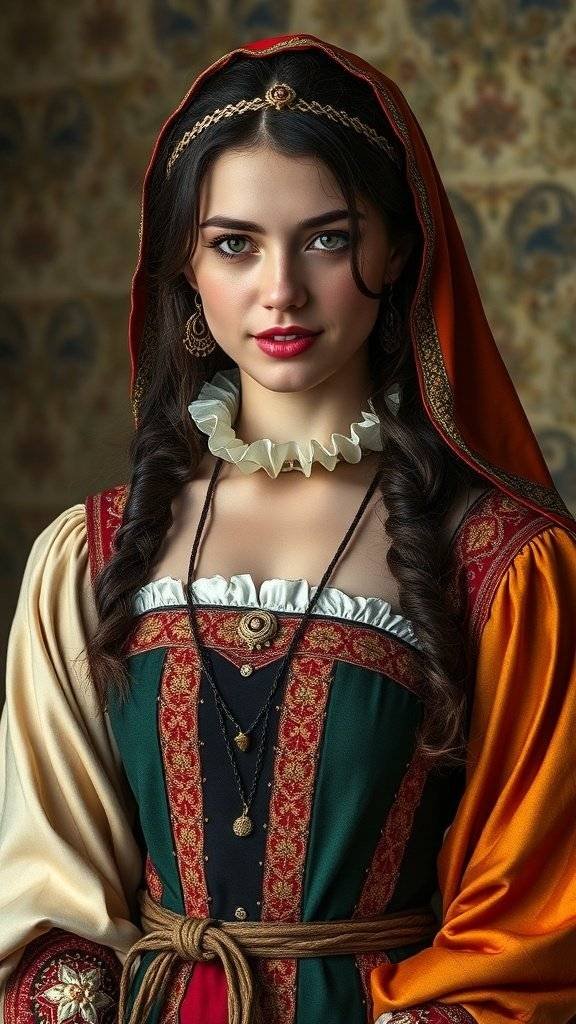
In the realm of Medieval Revivalism, color plays a significant role in expressing social status. The image showcases a variety of fabrics in rich hues, each telling a story of its own. The deep navy, vibrant red, and earthy yellow are not just visually appealing; they also symbolize different ranks and roles within society.
During the 14th and 15th centuries, colors were often associated with wealth and power. For instance, bright colors like red and gold were reserved for the nobility, while muted tones were more common among the lower classes. This distinction is reflected in the layered textures and flowing designs that characterize the outfits of the time.
The choice of fabric also matters. Luxurious materials like silk and velvet were favored by those of higher status, while simpler fabrics were used by common folk. The image captures this essence beautifully, showing how color and texture combine to reflect one’s place in the social hierarchy.
Artisan Techniques in Fabric Creation
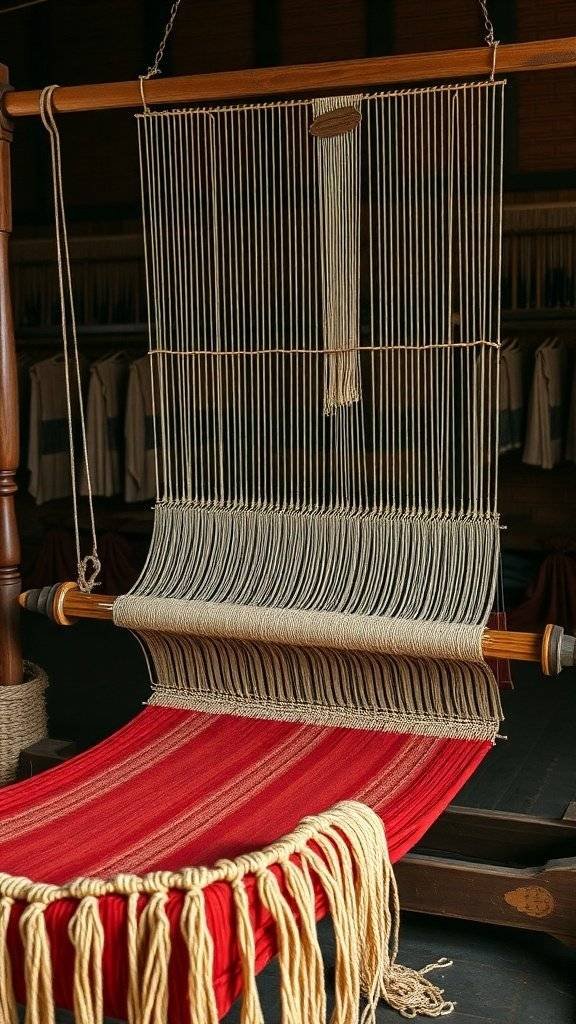
In the world of Medieval Revivalism, the artistry behind fabric creation plays a vital role. The image showcases a traditional loom, a tool that has been essential in weaving textiles for centuries. This craftsmanship reflects the dedication and skill of artisans who recreate the textures and patterns reminiscent of the 14th and 15th centuries.
The loom in the picture is set up with vibrant threads, hinting at the rich colors often used in medieval garments. The flowing gowns and corsets of that era were not just about style; they were about the quality of the fabric. Each piece was carefully crafted, often using techniques passed down through generations.
Artisans would spend hours at their looms, creating intricate designs that added depth and character to their work. The layered textures seen in modern interpretations of medieval outfits draw inspiration from these traditional methods. It’s fascinating how these techniques are revived today, allowing us to appreciate the beauty of historical fashion.
The Evolution of Corset Design
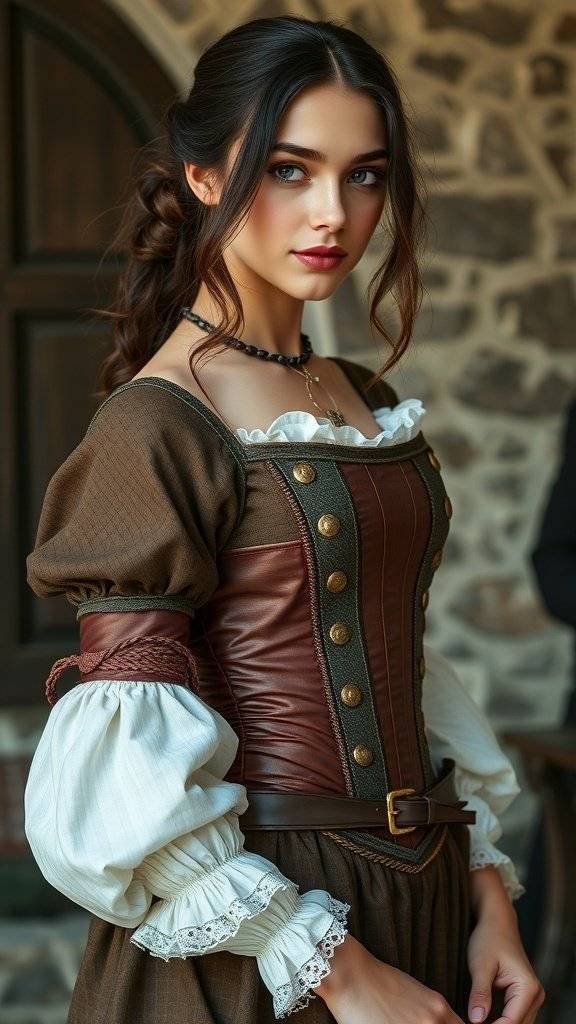
Corsets have a fascinating history, especially during the Medieval Revivalism period. The image showcases a trio of corsets, each with its unique style and design. The central corset, with its elegant curves and intricate lacing, represents the classic silhouette that many associate with the 14th and 15th centuries.
The corsets on either side highlight the variety in design, showcasing different textures and colors. This evolution reflects how corsets have transitioned from functional garments to fashion statements. In the past, they were often used to shape the body, but today, they serve as a nod to historical fashion while allowing for personal expression.
As we look at these designs, it’s clear that corsets have become more than just clothing. They symbolize a blend of history and modern style, making them a staple in contemporary wardrobes influenced by Medieval Revivalism.
Fabrics of the Medieval Era
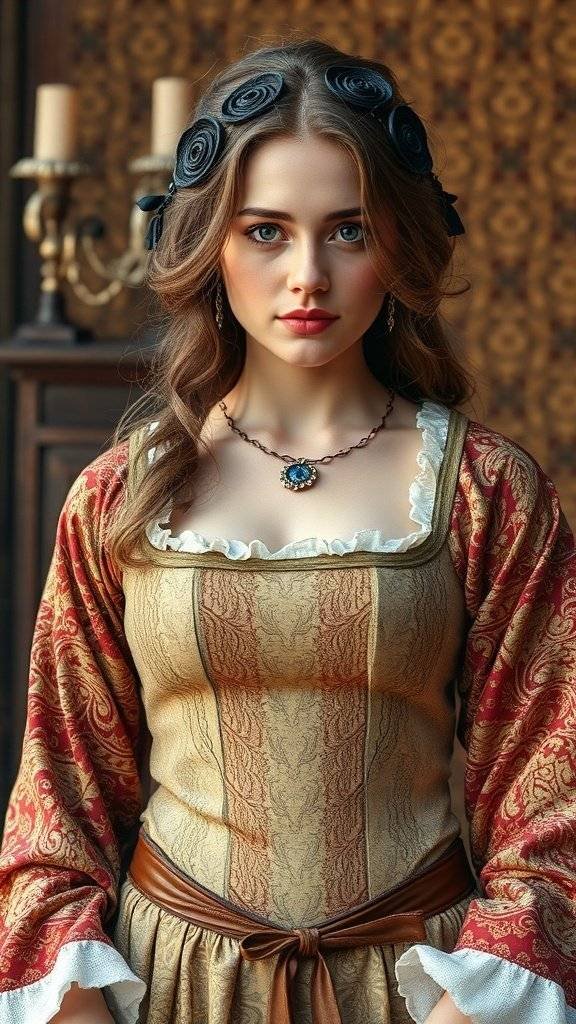
The medieval era was a time of rich textures and vibrant colors. Fabrics played a significant role in the fashion of the 14th and 15th centuries, showcasing the artistry and craftsmanship of the time. The image captures a beautiful array of textiles that reflect this period’s style.
In the picture, you can see a mix of luxurious materials like silk and brocade, adorned with intricate patterns. These fabrics were often used in flowing gowns and corsets, creating a stunning silhouette. The layered textures invite a sense of depth and elegance, making each piece unique.
Medieval Revivalism today draws inspiration from these historical fabrics. Designers often incorporate similar patterns and textures into modern outfits, blending the old with the new. The rich colors and detailed designs remind us of the craftsmanship that went into creating garments centuries ago.
Overall, the fabrics of the medieval era not only tell a story of fashion but also reflect the culture and artistry of the time. They continue to inspire contemporary styles, making them timeless in their appeal.
Capes and Cloaks for Dramatic Flair
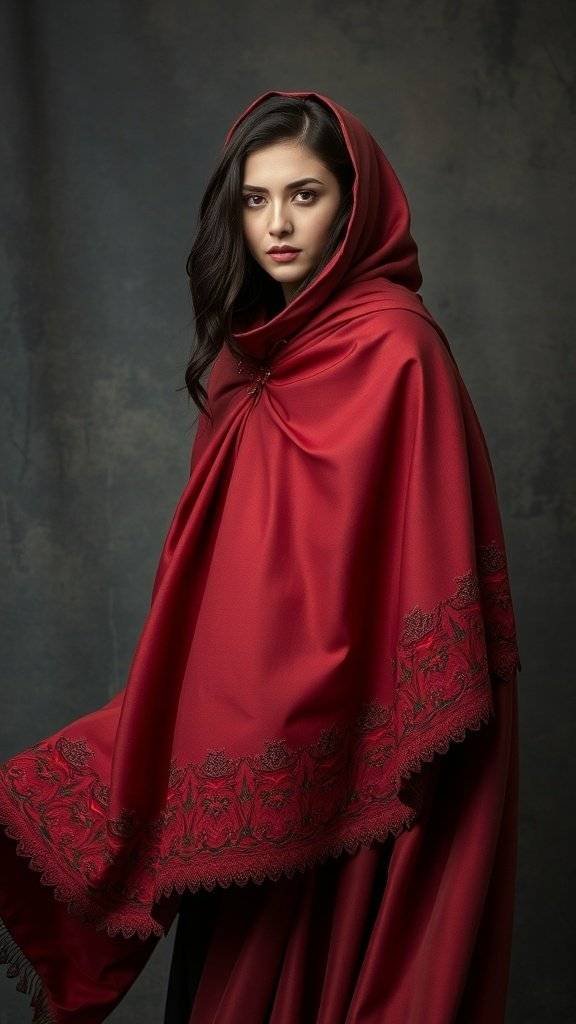
Capes and cloaks are the perfect way to add a touch of drama to any outfit inspired by Medieval Revivalism. These flowing garments evoke the elegance and grandeur of the 14th and 15th centuries, making them a staple in modern interpretations of medieval fashion.
The image captures a beautifully draped cloak, hinting at the luxurious fabrics and textures that were popular in medieval times. The soft, flowing material creates an inviting silhouette, while the intricate detailing at the hem suggests a level of craftsmanship that is often sought after in today’s fashion.
Wearing a cape or cloak can instantly transform a simple gown into something extraordinary. Whether you’re attending a themed event or just want to feel a bit more regal in your everyday life, these pieces are versatile and stylish. They can be layered over corsets and flowing gowns, adding depth and dimension to your look.
Incorporating capes and cloaks into your wardrobe not only pays homage to the past but also allows for personal expression. Choose colors and fabrics that resonate with you, and don’t shy away from bold patterns or embellishments. The right cape can make you feel like you’ve stepped right out of a medieval tale.
Embroidery and Appliqué in Detail
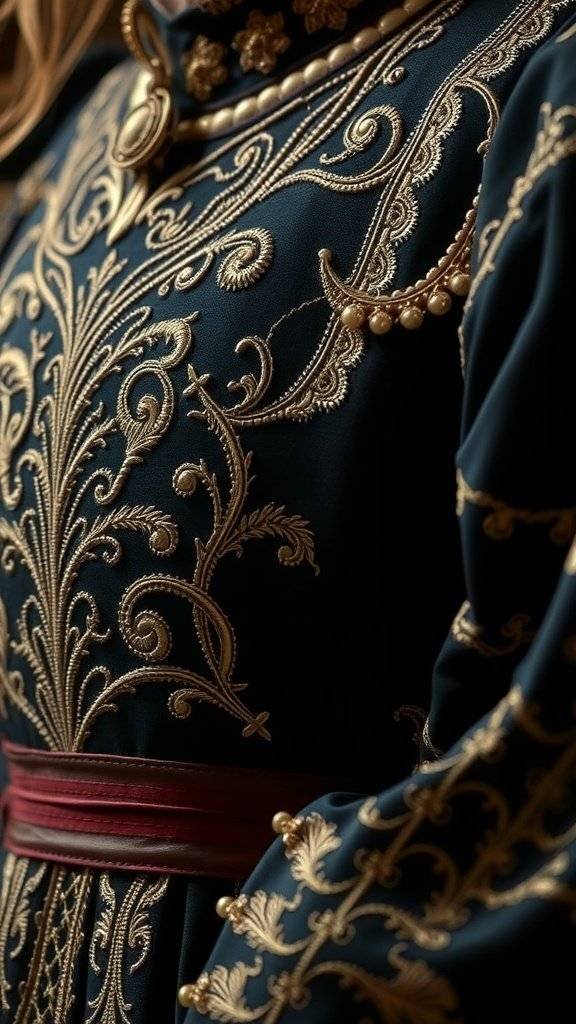
In the realm of Medieval Revivalism, embroidery and appliqué play a significant role in bringing historical fashion to life. The image showcases a stunning garment adorned with intricate gold embroidery against a rich, dark fabric. This design captures the essence of the 14th and 15th centuries, where such details were a mark of elegance and status.
The swirling patterns and delicate motifs are not just decorative; they tell a story of craftsmanship and artistry. Each stitch reflects the dedication of artisans who poured their skills into creating beautiful pieces. The use of gold thread adds a luxurious touch, making the outfit stand out in any setting.
The addition of a contrasting belt enhances the overall silhouette, drawing attention to the waist and creating a flattering shape. This layered approach to design is characteristic of the time, where garments often featured multiple textures and elements to create depth and interest.
Incorporating these elements into modern outfits allows wearers to connect with history while expressing their unique style. Whether for a themed event or everyday wear, such garments evoke a sense of nostalgia and appreciation for the artistry of the past.
Historical Patterns and Motifs
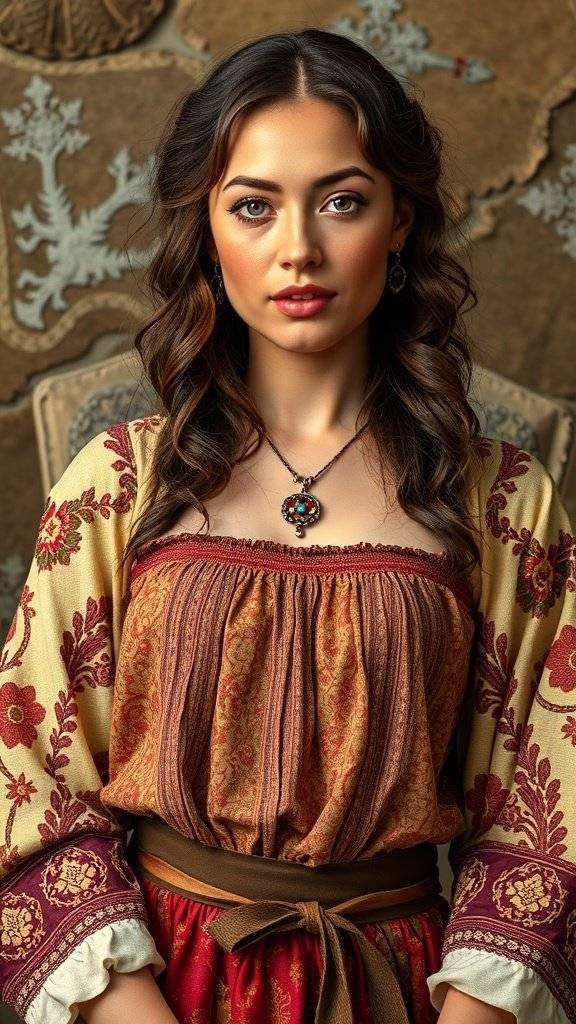
The image showcases a rich tapestry of patterns that echo the styles of the 14th and 15th centuries. The intricate designs feature a mix of floral motifs, geometric shapes, and mythical creatures, all rendered in vibrant colors like deep red, blue, and gold. These elements are reminiscent of the textiles used during the Medieval period, where fabric played a crucial role in expressing status and artistry.
Medieval Revivalism draws inspiration from these historical patterns, bringing them back into modern fashion. The use of corsets and flowing gowns often incorporates similar motifs, allowing wearers to connect with the elegance of the past. Each pattern tells a story, reflecting the craftsmanship and cultural significance of the era.
In this image, the detailed designs invite viewers to appreciate the artistry that went into creating textiles of the time. The combination of colors and shapes not only enhances the visual appeal but also serves as a reminder of the rich heritage that influences contemporary styles.
Fashionable Headpieces and Crowns
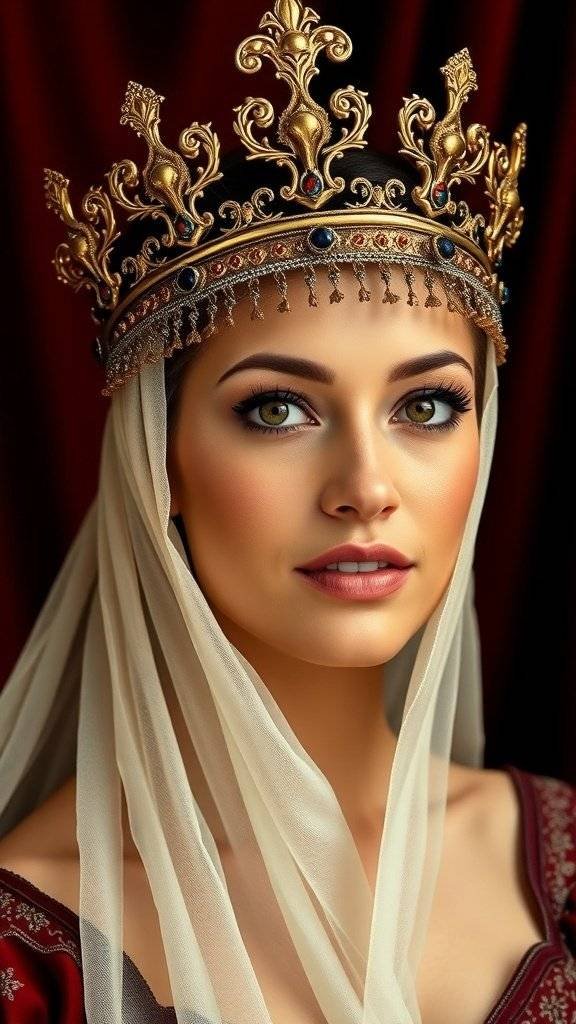
In the realm of Medieval Revivalism, headpieces and crowns play a vital role in completing the look. The image showcases an array of stunning headgear that reflects the elegance of the 14th and 15th centuries. Each piece tells a story, from the intricate designs to the luxurious materials used.
The crowns vary in style, with some adorned with jewels and others featuring delicate chains. This variety allows for personal expression while staying true to the medieval theme. The flowing fabrics draped over the mannequins add a touch of softness, balancing the hard edges of the crowns.
These headpieces can transform any outfit, making them perfect for themed events or costume parties. They evoke a sense of royalty and grandeur, inviting wearers to step into a different era. Whether you prefer a simple tiara or a grand crown, there’s something here for everyone.
The Significance of Sleeves
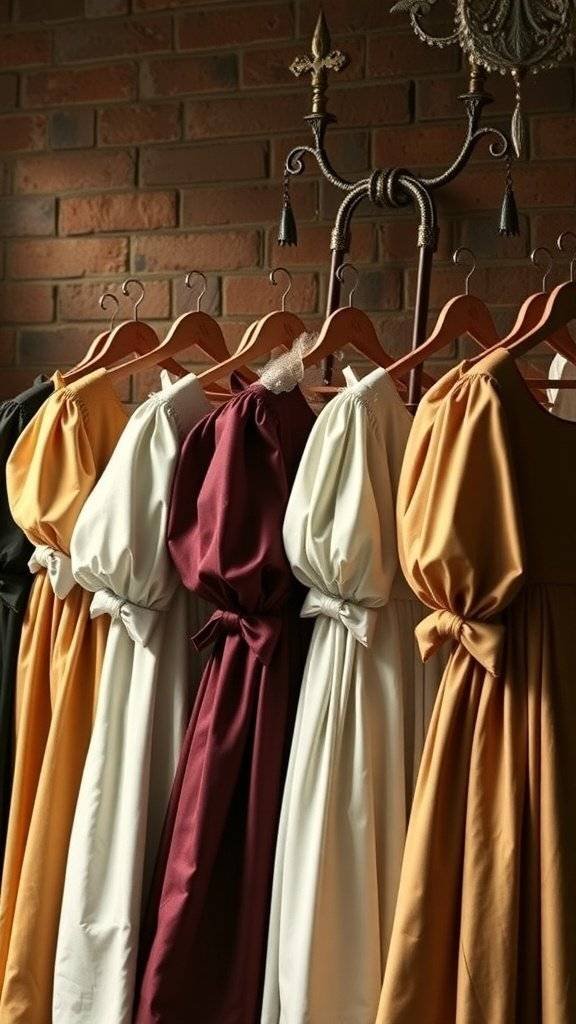
Sleeves play a vital role in the outfits inspired by Medieval Revivalism. They are not just functional; they add a unique flair to each gown. The image showcases a range of dresses, each with distinct sleeve styles, highlighting how sleeves can transform a simple dress into something special.
The puffed sleeves seen in the gowns evoke a sense of grandeur that was popular in the 14th and 15th centuries. This style brings a playful yet elegant touch to the overall look. The flowing nature of the fabric enhances movement, making the wearer feel graceful.
Moreover, the choice of colors in the dresses adds to their charm. Each hue tells a story and reflects the vibrant palette of medieval fashion. The layered textures and soft fabrics create a visual feast, inviting admiration.
In Medieval Revivalism, sleeves are more than just an accessory; they are a statement. They can convey personality and style, making each outfit unique. Whether it’s a romantic gathering or a themed event, the right sleeves can elevate any ensemble.
Influence of Religion on Clothing
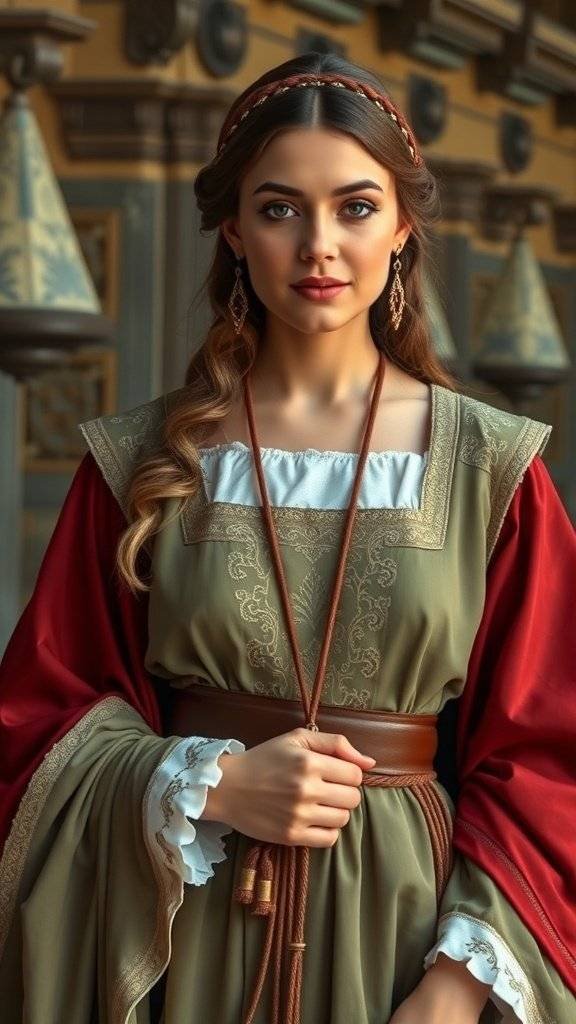
The image showcases a group of individuals dressed in rich, historical garments that reflect the religious attire of the 14th and 15th centuries. Their outfits are adorned with intricate details, symbolizing their status and roles within the religious community. This period saw clothing not just as a means of protection or fashion, but as a statement of faith and authority.
In Medieval Revivalism, we often see a revival of these styles, where flowing gowns and layered textures take center stage. The colors and fabrics used in these outfits often signify the wearer’s rank and religious affiliation. For instance, the deep reds and golds worn by some in the image suggest a high status, possibly indicating their roles as clergy or leaders within the church.
Religious influences shaped not only the design but also the purpose of clothing during this time. Garments were often designed to convey piety and devotion. The use of symbols, such as crosses or other religious motifs, was common, serving as reminders of faith and the divine. This connection between clothing and spirituality continues to inspire modern interpretations in fashion.
Dresses for Different Occasions
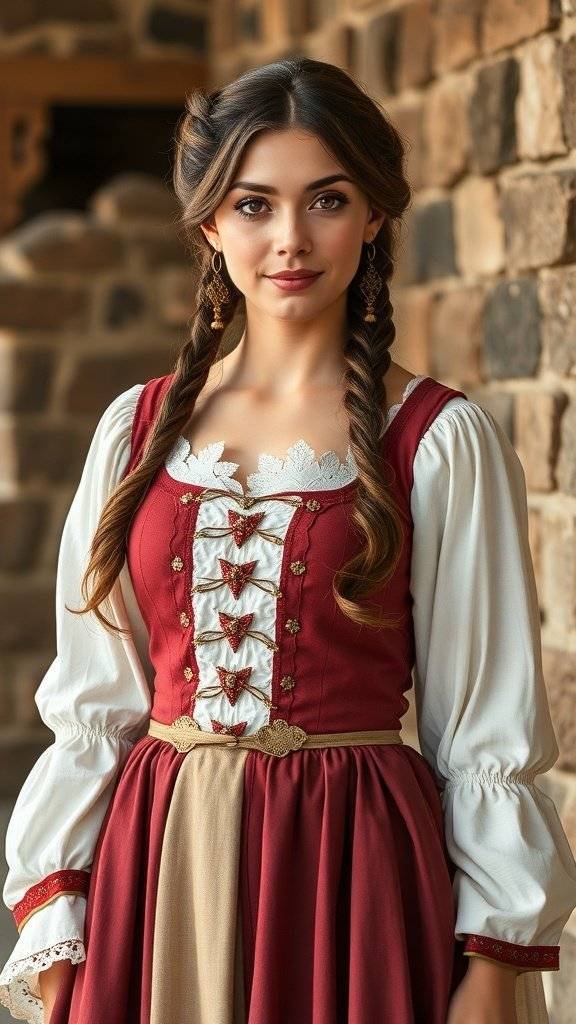
When it comes to Medieval Revivalism, dresses play a key role in capturing the essence of the 14th and 15th centuries. The image shows a variety of outfits that highlight the beauty and craftsmanship of this era. Each dress has its own unique style, making them suitable for different occasions.
For formal events, a flowing gown with intricate patterns and layers can make a stunning statement. The golden dress in the image, for example, is perfect for a grand banquet or a royal gathering. Its rich color and elegant silhouette draw attention while maintaining a sense of grace.
Casual gatherings can also benefit from the charm of medieval-inspired dresses. The simpler, yet stylish, designs like the one on the left offer comfort without sacrificing style. These outfits are great for festivals or themed parties where you want to stand out without being overly formal.
Lastly, the layered textures and corsets in these dresses provide versatility. They can be adjusted for comfort and fit, making them suitable for various body types. Whether you’re attending a wedding or a renaissance fair, there’s a dress in this collection that can meet your needs while celebrating the spirit of Medieval Revivalism.
The Art of Layering Textiles
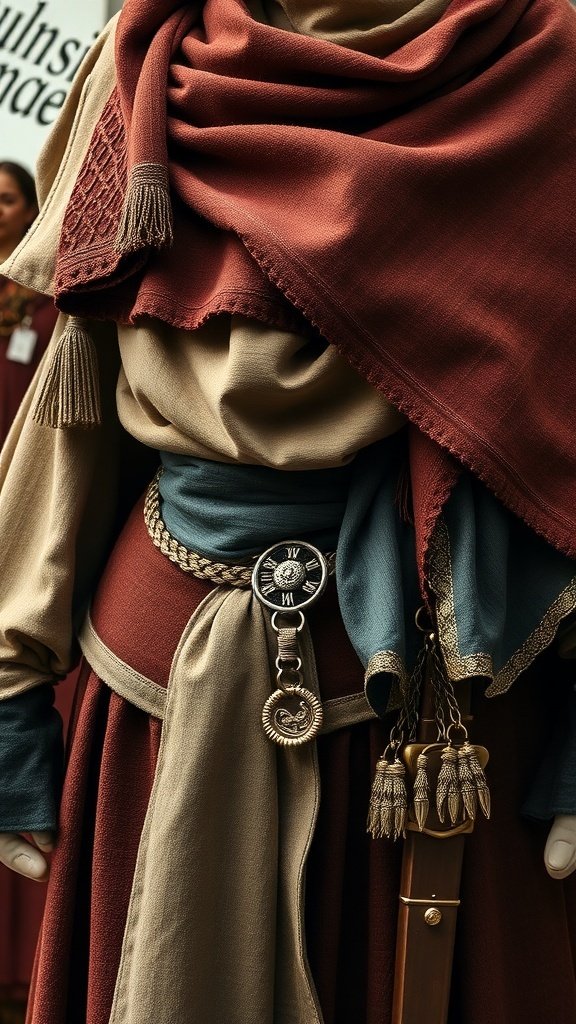
Layering textiles is a key element in Medieval Revivalism, and this outfit beautifully showcases that art. The combination of flowing gowns and structured corsets creates a stunning silhouette reminiscent of the 14th and 15th centuries.
The image features a rich palette of colors, including deep reds and earthy tones. These hues not only add depth but also reflect the natural dyes used in medieval fabrics. The layers are thoughtfully arranged, with a soft shawl draped elegantly over the shoulders, enhancing the overall look.
Textured fabrics play a significant role here. The intricate details, like the braided belt and tassels, bring a sense of craftsmanship that was highly valued in medieval times. Each layer tells a story, merging comfort with style.
As you explore Medieval Revivalism, consider how layering can transform your wardrobe. Mixing different textures and colors can create a unique aesthetic that pays homage to history while remaining contemporary.
Renaissance Inspirations in Medieval Revivalism
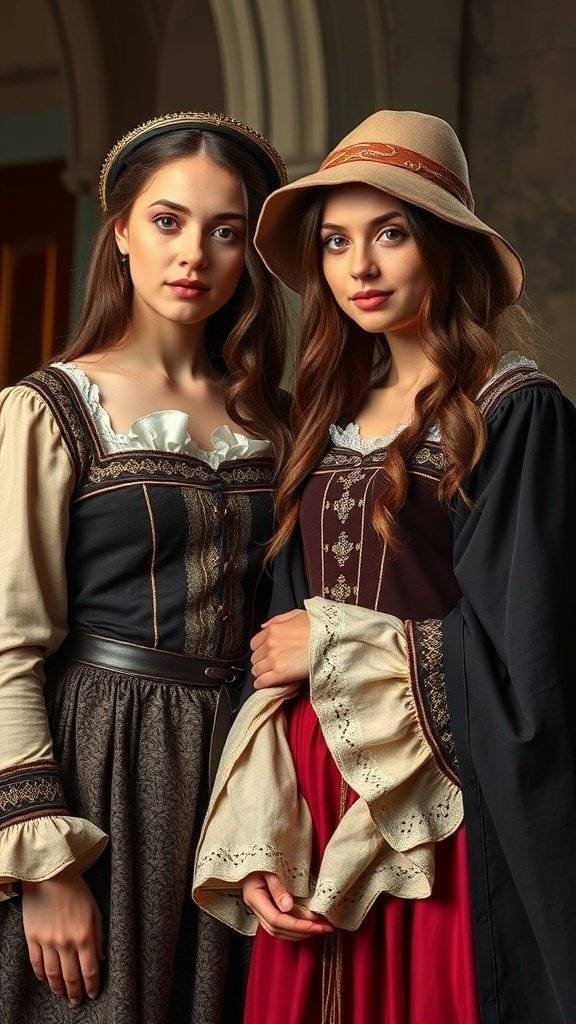
Medieval Revivalism brings a fresh take on historical fashion, drawing heavily from the Renaissance era. The image showcases stunning outfits that reflect the elegance of the 14th and 15th centuries. Each piece tells a story, blending rich fabrics and intricate designs.
The first outfit features a deep blue gown adorned with ornate patterns, hinting at the luxurious textiles of the time. Its flowing silhouette captures the grace of Renaissance fashion, perfect for anyone wanting to channel that era’s charm.
Next, the striking red gown stands out with its bold color and delicate details. The hood adds a touch of mystery, making it a perfect choice for events or themed gatherings. This outfit embodies the spirit of Medieval Revivalism, merging historical influences with modern sensibilities.
Finally, the earthy green ensemble offers a more understated yet equally captivating option. Its simplicity and comfort make it versatile, appealing to those who appreciate both style and practicality. Together, these outfits celebrate the beauty of the past while inviting us to wear history in our everyday lives.
Jewelry Trends of the 14th Century
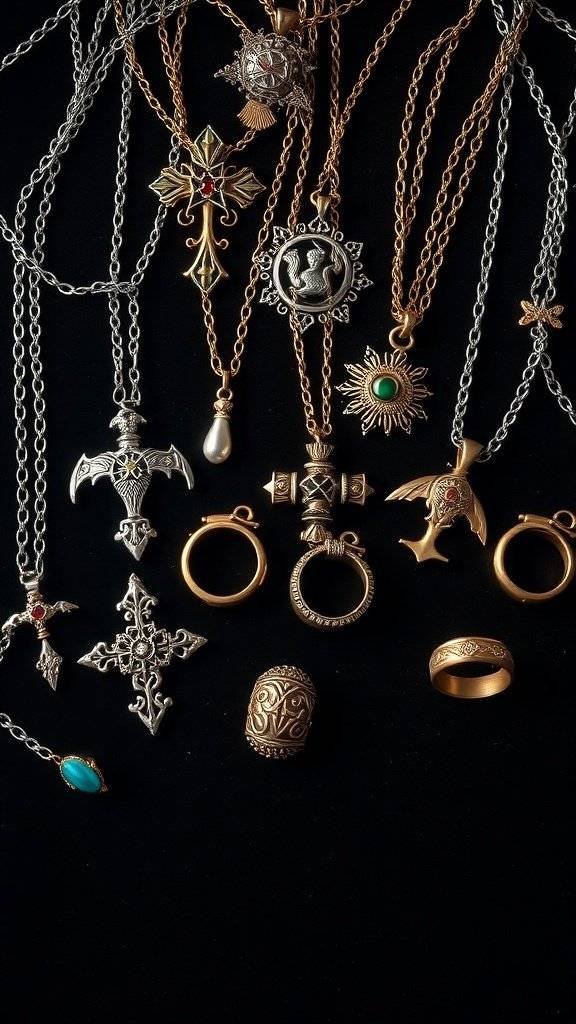
The 14th century was a vibrant time for jewelry, reflecting the styles and values of Medieval Revivalism. The image showcases a stunning array of necklaces and pendants, each telling a story of craftsmanship and artistry.
Jewelry in this era often featured intricate designs, with symbols that held deep meaning. Crosses, like those seen in the image, were popular and represented faith and protection. The use of precious metals and gemstones added a touch of luxury, making these pieces not just accessories, but statements of status.
Layered textures were a hallmark of the time, with chains of varying lengths creating a dynamic look. The combination of silver and gold, along with colorful stones, brought a lively contrast that was highly sought after. This layering also allowed for personal expression, as individuals mixed and matched pieces to reflect their unique style.
As we look at the jewelry from this period, it’s clear that these designs have influenced modern fashion. Today, many are inspired by the elegance and symbolism of 14th-century jewelry, incorporating similar elements into contemporary outfits. This connection to the past is a key aspect of Medieval Revivalism, celebrating the beauty and significance of historical adornments.
Symbolism in Medieval Fashion
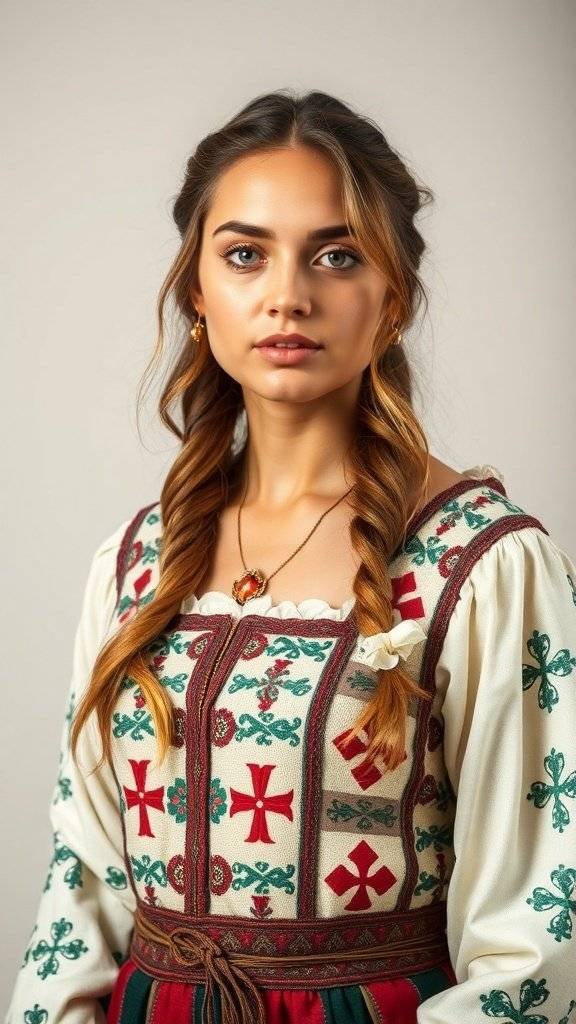
Medieval Revivalism brings back the charm of the 14th and 15th centuries through stunning outfits. The image showcases individuals dressed in flowing gowns and layered textures, each piece telling a story of its own. The colors and patterns reflect the artistry of the time, emphasizing status and identity.
In this scene, the rich fabrics and intricate designs symbolize not just fashion, but also the social hierarchy of the medieval era. The way people are dressed indicates their roles and ranks within society. For instance, the use of vibrant colors and elaborate embroidery often signified nobility, while simpler garments were worn by the lower classes.
The corsets and flowing gowns are more than just clothing; they represent the ideals of beauty and femininity of the time. These elements of Medieval Revivalism remind us of how fashion can convey deeper meanings about culture and society.
Fashion and Identity in the 14th Century
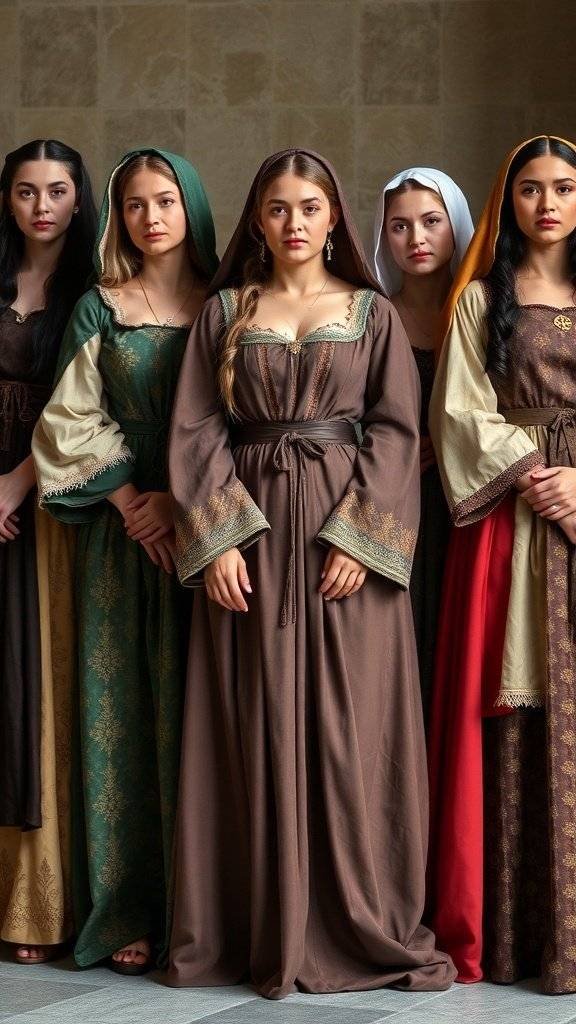
The image captures a group of individuals dressed in outfits inspired by the 14th century. Each person showcases a unique style, featuring corsets, flowing gowns, and layered textures that reflect the fashion of the time. The rich colors and intricate designs highlight the craftsmanship of medieval clothing. This era was marked by a blend of social status and personal identity, with clothing serving as a key indicator of one’s place in society. The flowing gowns and corsets not only accentuated the wearers’ figures but also conveyed their roles within their communities. Medieval Revivalism today draws from these historical elements, celebrating the beauty and complexity of past fashions. The outfits in the image remind us of how clothing can express individuality while connecting us to a shared history.
The Role of Tailors and Seamstresses
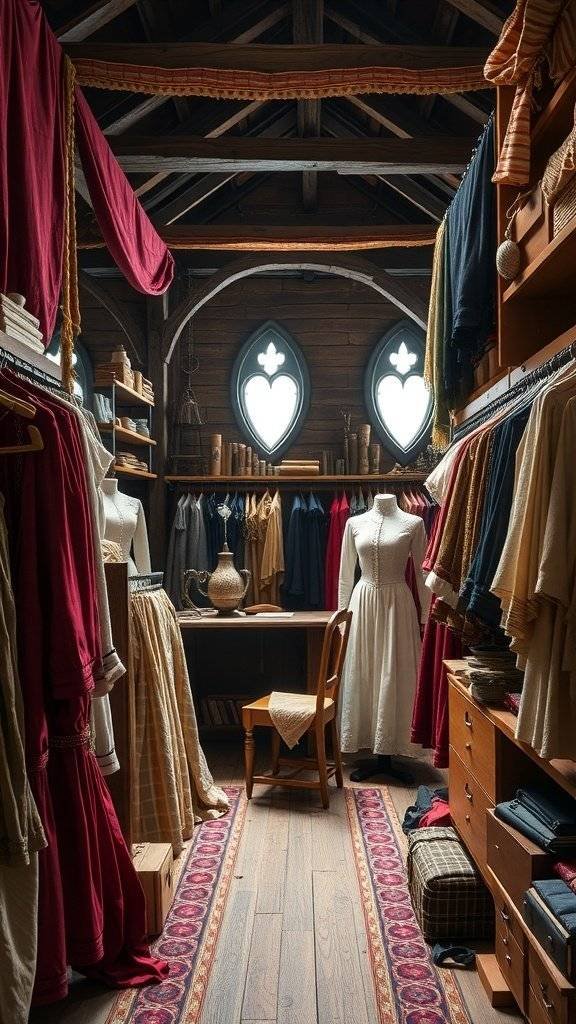
In the world of Medieval Revivalism, tailors and seamstresses play a vital role in bringing historical fashion back to life. The image captures a cozy workshop filled with rich fabrics and flowing gowns, reminiscent of the 14th and 15th centuries. Here, creativity and craftsmanship blend seamlessly.
These skilled artisans are responsible for crafting outfits that reflect the elegance of medieval attire. The corsets, flowing gowns, and layered textures seen in the image showcase their expertise. Each piece is carefully designed to echo the styles of the past while ensuring comfort for modern wearers.
In this workshop, you can see a variety of fabrics hanging, each waiting to be transformed into a stunning garment. The presence of tools and patterns hints at the meticulous work that goes into every creation. Tailors and seamstresses not only stitch fabric together but also weave stories of history into their designs.
As Medieval Revivalism gains popularity, these artisans are more essential than ever. They help people connect with the past through fashion, making history accessible and enjoyable. Their dedication ensures that the beauty of medieval styles continues to inspire and delight.
Cultural Exchanges and Fashion
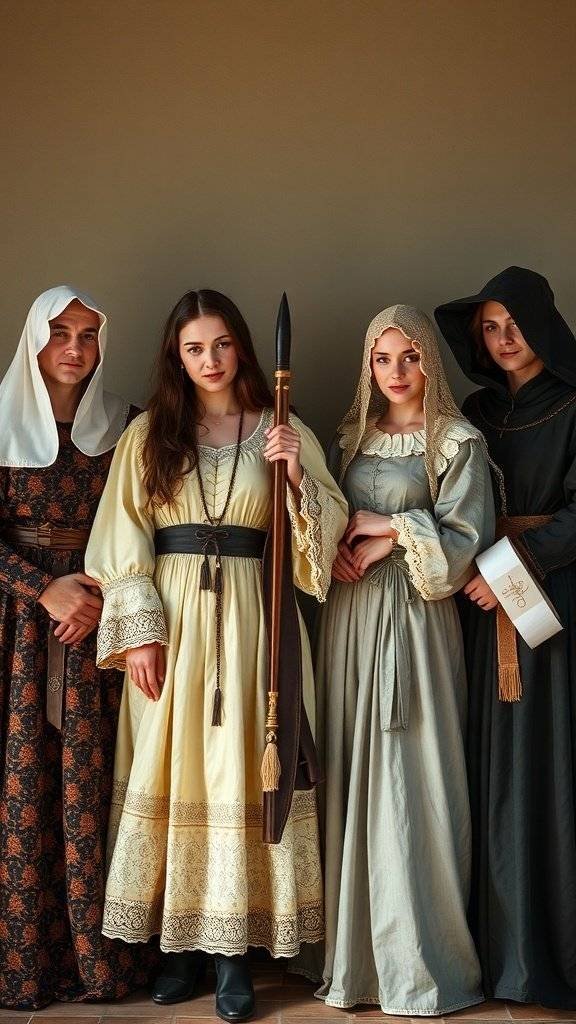
The image showcases a group of individuals dressed in outfits inspired by Medieval Revivalism. Their attire features corsets, flowing gowns, and layered textures that reflect styles from the 14th and 15th centuries. Each outfit tells a story of its own, blending historical elements with modern interpretations.
The flowing gowns, with their intricate details and rich fabrics, highlight the craftsmanship of the time. The corsets emphasize the silhouette that was popular during the medieval period, while the layered textures add depth and interest to the overall look. This revival of medieval fashion is not just about aesthetics; it’s a celebration of cultural heritage.
Fashion during the medieval era was influenced by various cultural exchanges. Trade routes brought new materials and ideas, allowing styles to evolve. The outfits in the image reflect this blend, showcasing how different cultures contributed to the fashion landscape. As people embraced these historical styles, they also created a dialogue between past and present, making medieval fashion relevant today.
Influence of Trade on Fabric Availability
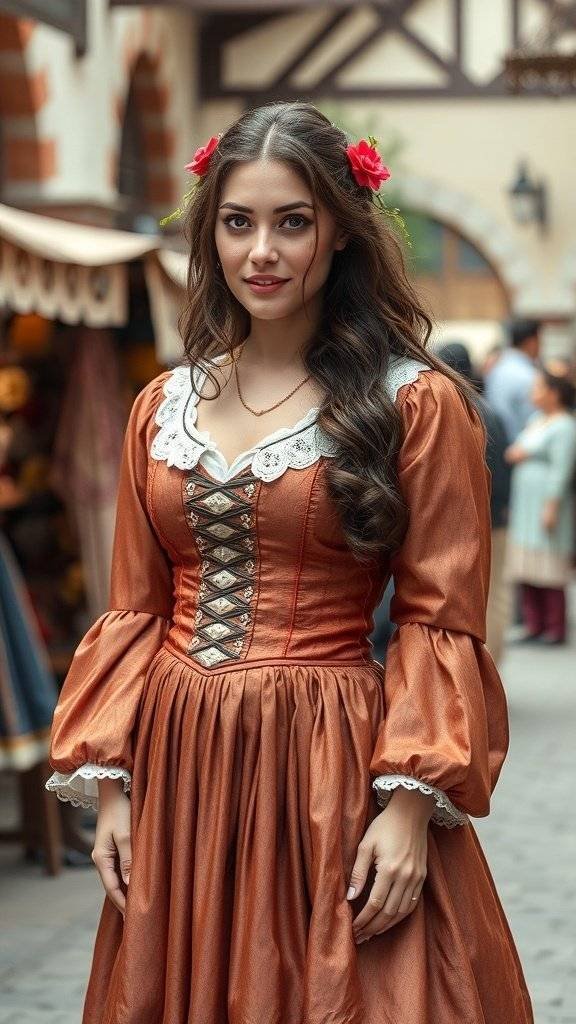
The image captures a lively medieval marketplace, showcasing a variety of fabrics and garments that reflect the essence of Medieval Revivalism. You can see merchants displaying colorful textiles, which were essential in creating the flowing gowns and corsets reminiscent of the 14th and 15th centuries.
Trade played a significant role in the availability of these fabrics. As merchants traveled across regions, they brought back exotic materials like silk and fine wool. This exchange not only enriched local wardrobes but also influenced fashion trends. The vibrant colors and intricate patterns seen in the marketplace highlight how trade opened doors to new styles and textures.
In this bustling scene, you can spot baskets filled with textiles and fruits, symbolizing the blend of commerce and daily life during that era. The layered textures of the garments on display are a testament to the craftsmanship that flourished thanks to the diverse materials available through trade routes. Medieval Revivalism draws inspiration from this rich history, celebrating the beauty and complexity of these outfits.
Seasonal Variations in Medieval Attire
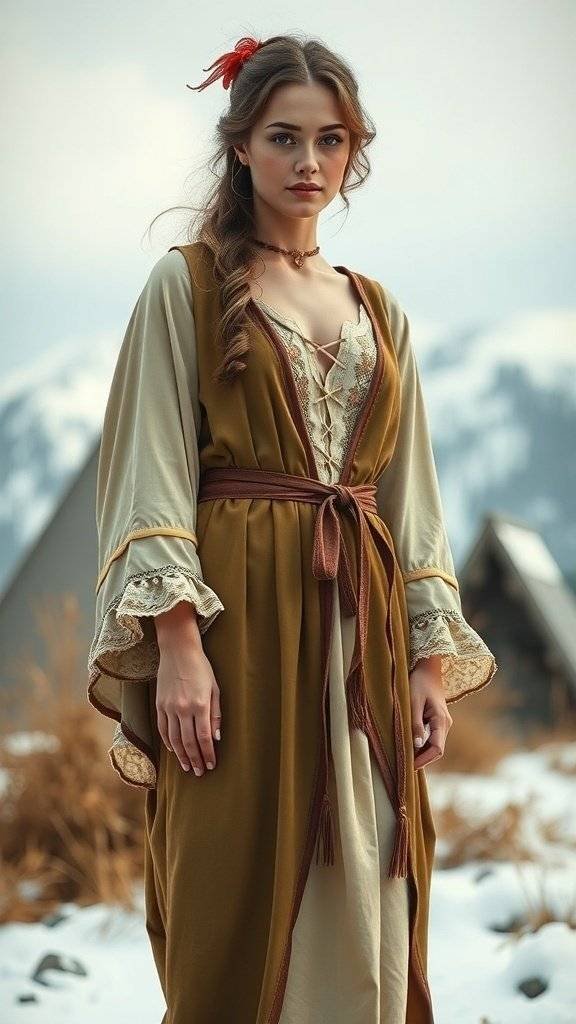
Medieval Revivalism brings back the charm of the 14th and 15th centuries, and seasonal variations play a big role in how these outfits are styled. In the image, we see a couple dressed in summer-inspired medieval attire, showcasing the lighter fabrics and colors typical of warmer months.
The woman wears a flowing gown in earthy tones, complemented by a wide-brimmed straw hat. This type of dress was practical for summer, allowing for breathability while still looking elegant. The soft, billowy sleeves add a touch of femininity, making it perfect for a warm day.
On the other hand, the man’s outfit features layered textures that hint at medieval practicality. His hooded cloak, made from heavier fabric, suggests that he’s prepared for cooler summer evenings. The combination of colors and textures reflects the style of the era while being suitable for the season.
Seasonal variations in medieval attire not only highlight the beauty of the garments but also their functionality. Each piece is designed to keep the wearer comfortable, whether in the heat of summer or the chill of winter. This thoughtful approach to clothing is a key aspect of Medieval Revivalism, celebrating both style and practicality.
The Craft of Tailoring in the Middle Ages
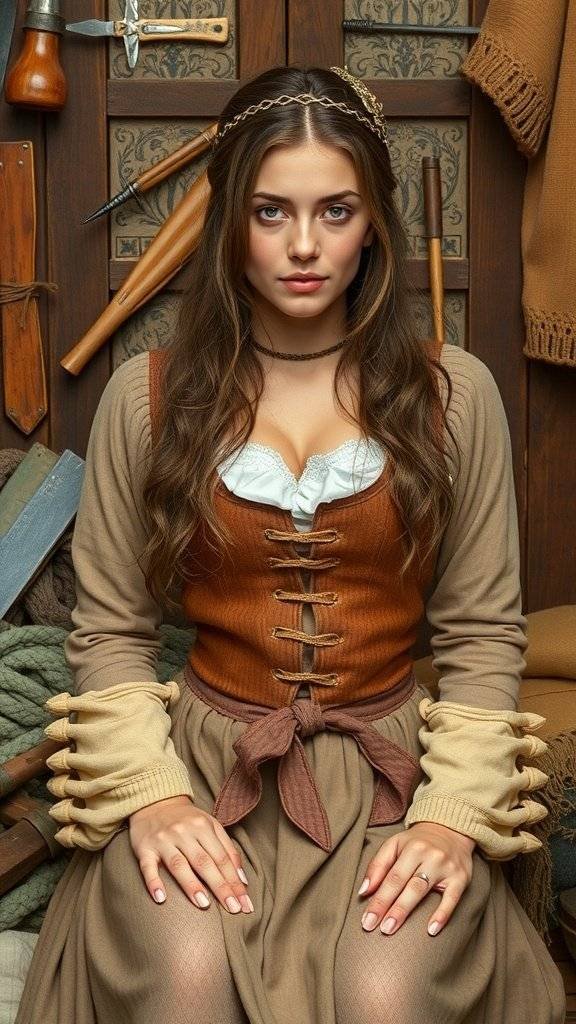
The image captures a charming scene that reflects the art of tailoring during the Middle Ages. A mannequin dressed in a layered outfit stands proudly in a cozy workshop filled with tools and materials. The warm tones of the fabric and the rustic setting evoke a sense of history and craftsmanship.
In medieval times, tailoring was not just a skill; it was a vital part of everyday life. Tailors created garments that were both functional and beautiful. The flowing gowns and fitted corsets we admire today have roots in this era, showcasing the intricate work that went into each piece.
The workshop depicted in the image is reminiscent of those bustling with activity. Tailors would often work with various fabrics, using techniques passed down through generations. The sewing machines and tools hint at the evolution of tailoring, blending traditional methods with new innovations.
Medieval Revivalism celebrates these historical influences, bringing back the elegance of the 14th and 15th centuries. The layered textures and careful tailoring seen in modern outfits pay homage to the craftsmanship of the past, reminding us of the artistry involved in creating clothing.
Fashion Shows Featuring Medieval Revivalism
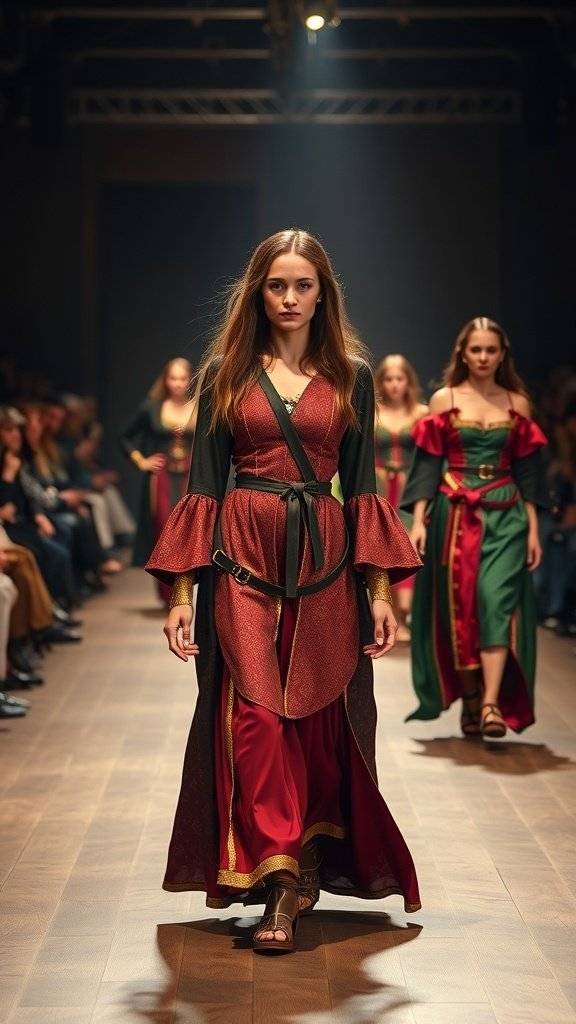
Fashion shows today often draw inspiration from various historical periods, and Medieval Revivalism is a standout trend. The image captures models strutting down the runway, showcasing outfits that blend corsets, flowing gowns, and layered textures reminiscent of the 14th and 15th centuries.
The vibrant colors and intricate designs highlight the craftsmanship involved in these garments. Each piece tells a story, echoing the elegance of medieval attire while adding a modern twist. The flowing gowns, adorned with rich fabrics, create a striking visual that captivates the audience.
As the models walk, the atmosphere buzzes with excitement. The audience is transported back in time, appreciating the blend of history and contemporary fashion. This revival not only celebrates medieval styles but also encourages designers to experiment with textures and silhouettes.
Fashion shows featuring Medieval Revivalism are more than just displays of clothing. They invite viewers to experience a unique blend of art and history, making each event a memorable occasion.
Recreating Historical Outfits Today
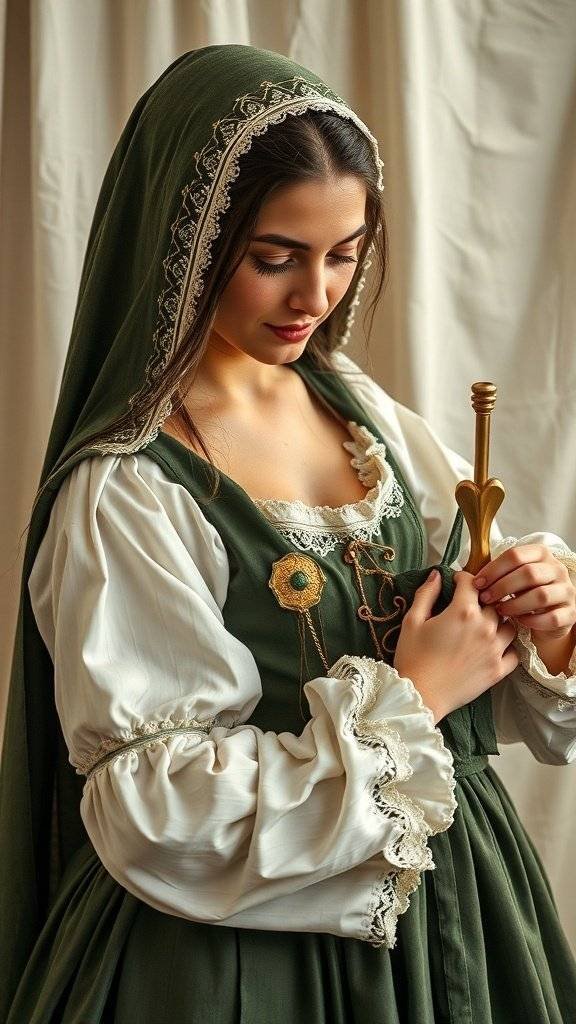
Medieval Revivalism has sparked a renewed interest in the fashion of the 14th and 15th centuries. The image showcases a stunning outfit that embodies this trend. The flowing gown, paired with a corset, highlights the elegance and craftsmanship of the era.
The model is seated, focused on her task, which adds a sense of authenticity to the scene. The rich green fabric of the gown, combined with layered textures, reflects the attention to detail that was characteristic of medieval clothing. Accessories like the belt and the rolled fabric beside her hint at the process of creating or adjusting garments.
This revival is not just about wearing historical outfits; it’s about appreciating the artistry and stories behind them. Many enthusiasts today recreate these styles for events, performances, or simply for the joy of wearing something that connects them to the past.
Reviving Traditional Craftsmanship
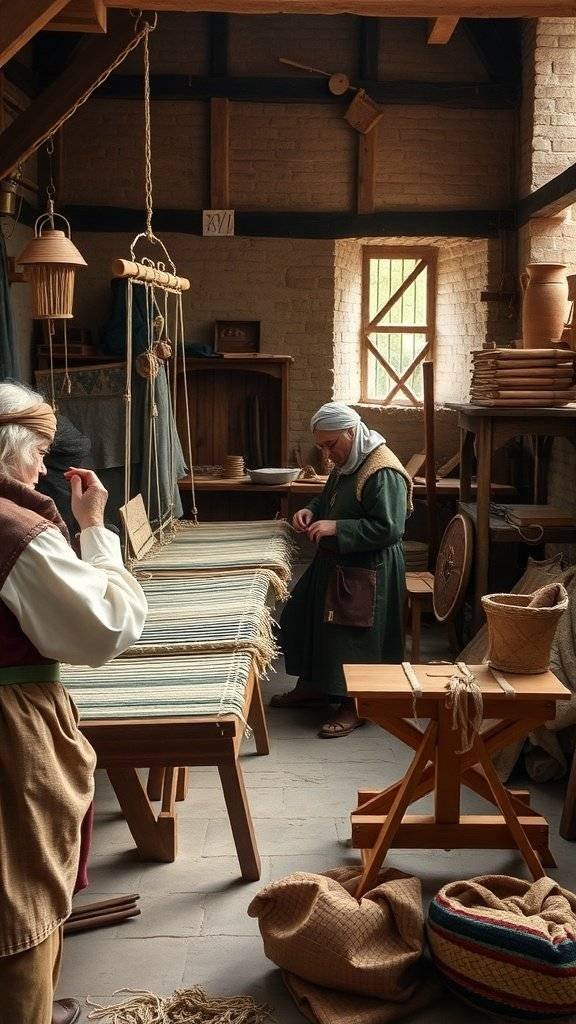
The image captures a scene reminiscent of a medieval workshop, where artisans are engaged in traditional textile creation. This setting highlights the craftsmanship that defined the 14th and 15th centuries. The women are focused on their work, showcasing the skills passed down through generations.
Medieval Revivalism brings back these age-old techniques, emphasizing the beauty of handmade items. The flowing gowns and corsets we admire today often draw inspiration from this rich history. The textures and layers seen in the garments reflect the intricate work that artisans put into their craft.
In today’s world, there’s a growing appreciation for these traditional methods. Many modern designers are looking back to the past, incorporating elements of medieval styles into contemporary fashion. This revival not only honors the craftsmanship of the time but also connects us to a more tactile and authentic way of creating clothing.
The Influence of Literature on Fashion Trends
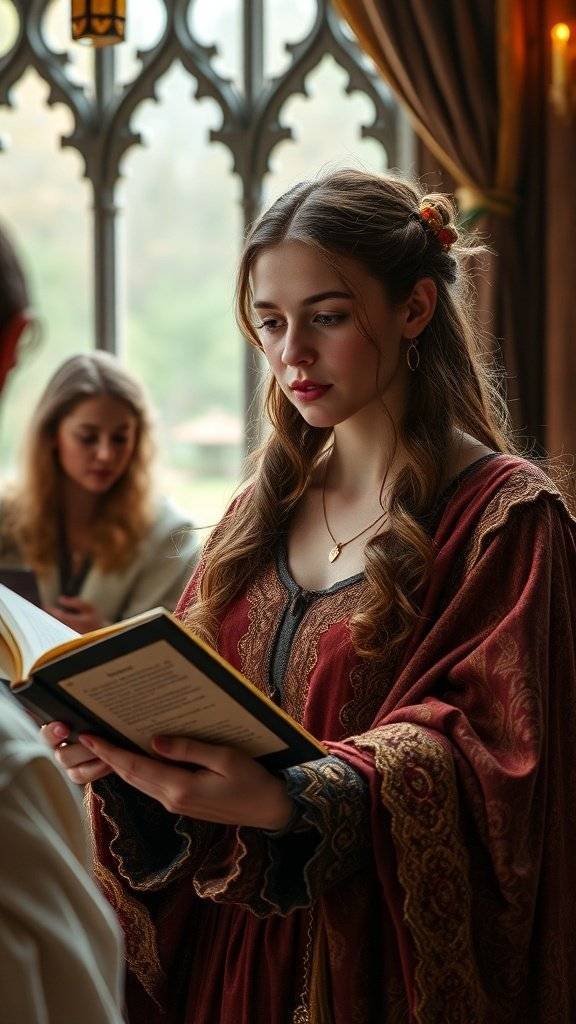
In the realm of Medieval Revivalism, literature plays a key role in shaping fashion trends. The image captures three figures engrossed in reading, dressed in outfits that echo the styles of the 14th and 15th centuries. Their attire, featuring flowing gowns and layered textures, reflects the elegance of medieval fashion.
The characters in the image seem to be lost in stories that may inspire their clothing choices. Literature from this era often described the grandeur of court life, influencing how people dressed to reflect their status and identity. This connection between storytelling and fashion is vital.
As tales of knights, ladies, and epic quests circulated, they not only entertained but also set trends. The vibrant colors and intricate designs seen in the outfits of the figures suggest a desire to embody the characters they read about. This interplay between literature and fashion continues to inspire modern designs that celebrate the beauty of the past.
The Connection Between Art and Fashion
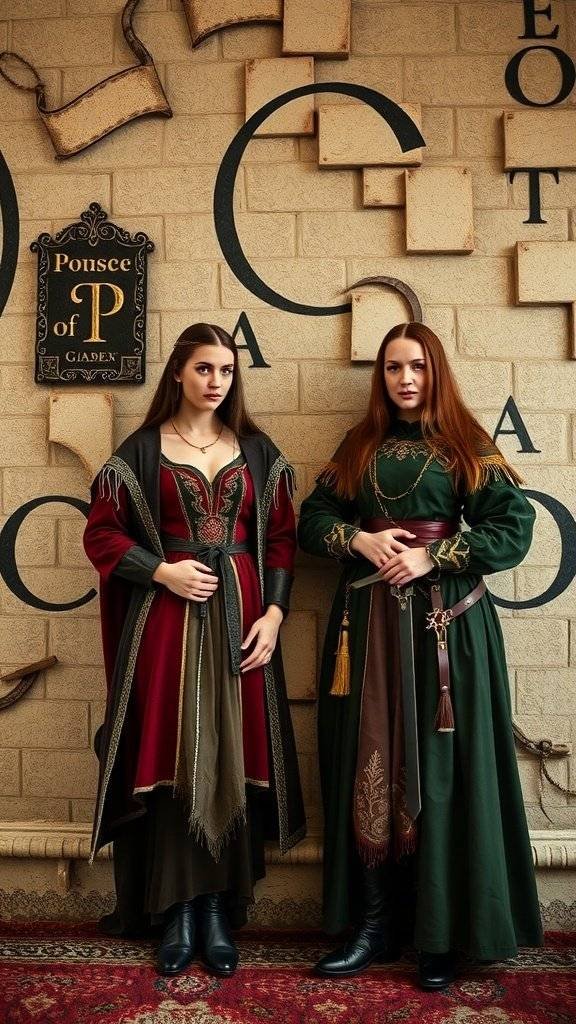
Medieval Revivalism brings a unique blend of history and creativity into modern fashion. The image showcases two women dressed in stunning outfits that echo the styles of the 14th and 15th centuries. Their corsets and flowing gowns highlight the craftsmanship that defines this era.
The rich colors and layered textures in their attire reflect the artistry of medieval clothing. Each detail, from the embroidery to the choice of fabric, tells a story of a time long past. This connection between art and fashion is not just about aesthetics; it’s about reviving the spirit of an age.
Fashion often draws inspiration from art, and in this case, the outfits serve as a canvas for historical expression. The way these garments are styled can inspire contemporary designers to incorporate similar elements into their work. By blending the old with the new, we see how fashion can keep history alive.
The Impact of War on Clothing Styles
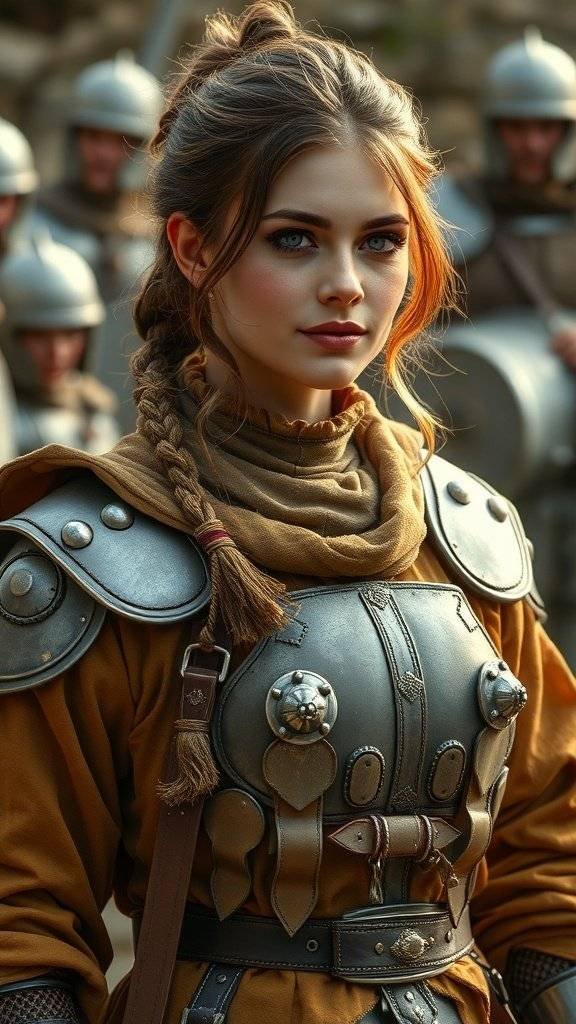
War has always influenced fashion, and the medieval period is no exception. The image shows a group dressed in armor and flowing garments, reflecting the styles of the 14th and 15th centuries. The combination of protective gear and elegant attire highlights how necessity shaped aesthetics.
During times of conflict, clothing often served dual purposes. Armor was essential for protection, while the layers and textures of gowns indicated status and wealth. The contrast between the sturdy metal and soft fabrics tells a story of survival and elegance.
Medieval Revivalism draws inspiration from these historical styles, blending practicality with beauty. The revival of corsets and flowing gowns pays homage to a time when clothing was not just about fashion but also about function. This connection to history gives modern outfits a unique depth, reminding us of the past’s influence on today’s trends.
Sustainable Practices in Medieval Clothing
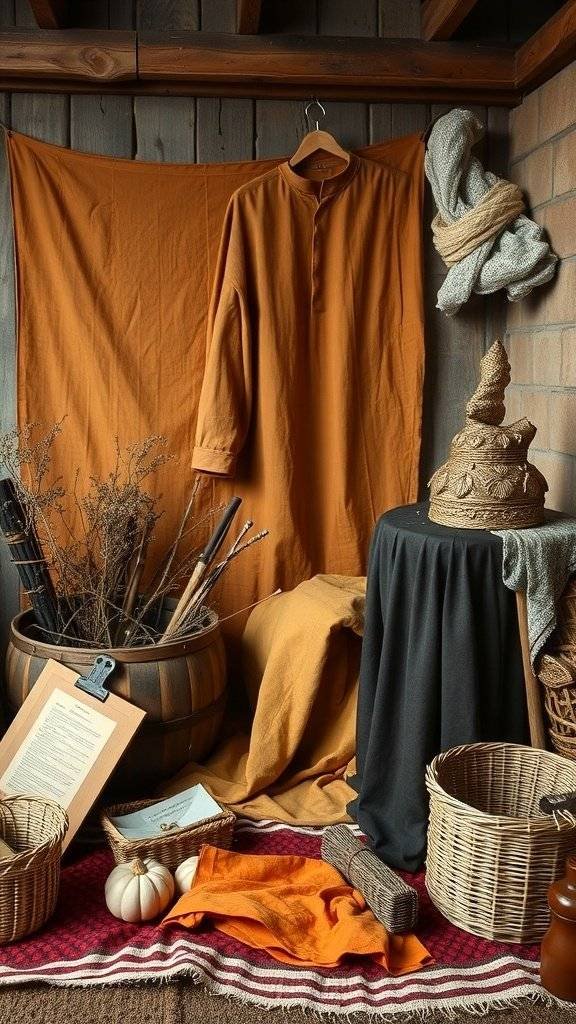
Medieval Revivalism brings back the charm of the 14th and 15th centuries, showcasing outfits that include corsets, flowing gowns, and layered textures. The image captures a cozy setting filled with earthy tones and natural materials, reflecting the sustainable practices of that era.
The use of natural fibers and simple dyes in medieval clothing promotes eco-friendly choices. The orange garment hanging on the wall is a great example of how colors were derived from plants and minerals, minimizing environmental impact.
In the image, we see various baskets and a wooden barrel, which highlight the importance of reusing materials. Back in medieval times, people made the most of what they had, often repurposing items for different uses. This approach is gaining popularity today as more people seek sustainable fashion.
Textiles like wool and linen were common, and they are making a comeback in modern designs. The layered textures in the image suggest a thoughtful approach to fabric choices, emphasizing comfort and durability. By embracing these methods, we can enjoy the beauty of medieval styles while being kind to our planet.
Fashionable Elements in Everyday Life
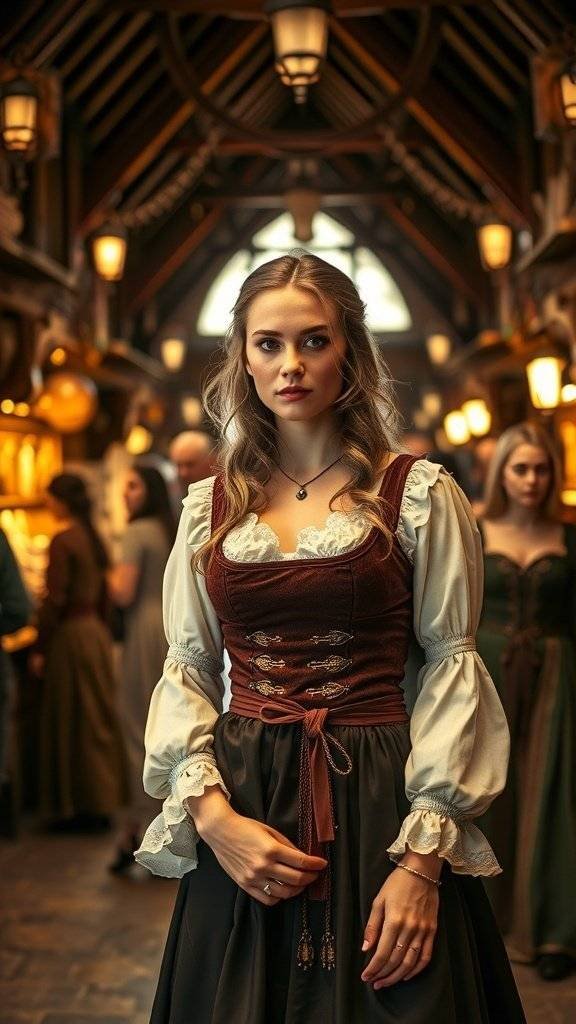
In the heart of a bustling medieval market, we see a vibrant scene that captures the essence of Medieval Revivalism. People are dressed in outfits that echo the styles of the 14th and 15th centuries. The flowing gowns and layered textures create a sense of elegance and history.
Notice the rich colors and intricate details in the clothing. Each outfit tells a story, blending comfort with style. The corsets and flowing fabrics are not just for show; they reflect a time when fashion was an art form. This revival of medieval styles brings a unique flair to everyday life.
As you walk through the market, you can almost feel the energy of the past. The architecture around you complements the fashion, creating a picturesque backdrop. This scene reminds us that fashion can be a bridge to history, allowing us to express ourselves while honoring traditions.
The Role of Fashion in Social Hierarchy
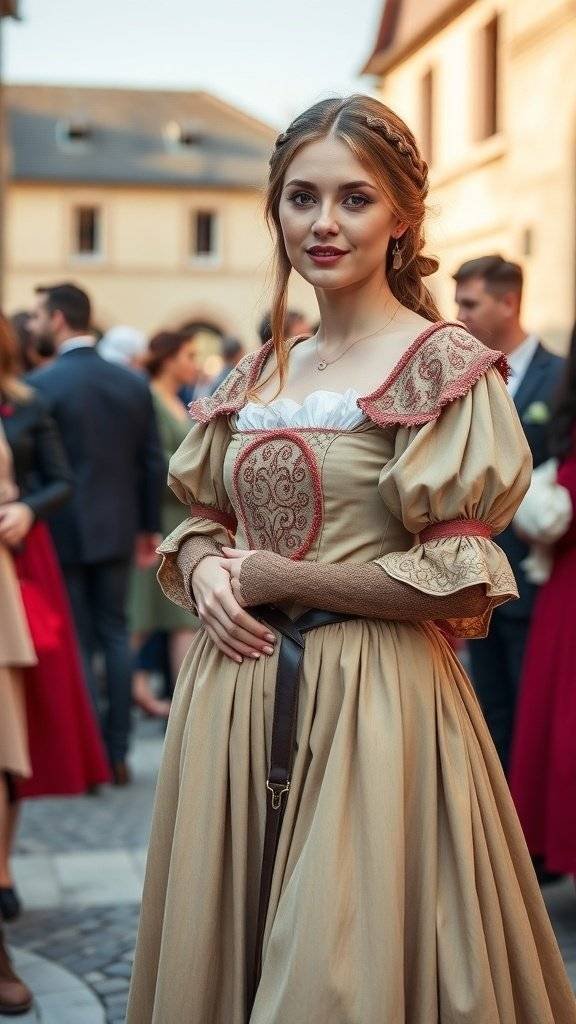
Fashion has always played a key role in defining social status, especially during the medieval period. In the image, we see a group of individuals dressed in outfits that reflect the styles of the 14th and 15th centuries. The flowing gowns and corsets are not just beautiful; they signify the wearers’ positions in society.
The woman in the striking red gown stands out, suggesting she may belong to a higher social class. Her attire, complete with intricate details, showcases wealth and status. The other figures, dressed in simpler garments, represent different societal roles, perhaps indicating their lower status.
Layered textures and rich colors were essential in medieval fashion. They communicated not only personal style but also wealth and influence. The use of specific fabrics and embellishments helped people identify each other’s rank at a glance. This visual language of clothing was crucial in a time when social hierarchy was rigidly defined.
Medieval Revivalism today seeks to capture this essence. Modern interpretations of these outfits allow us to appreciate the historical significance of fashion. By wearing these styles, we connect with the past and recognize how clothing has always been a reflection of societal structure.
Futuristic Takes on Medieval Styles
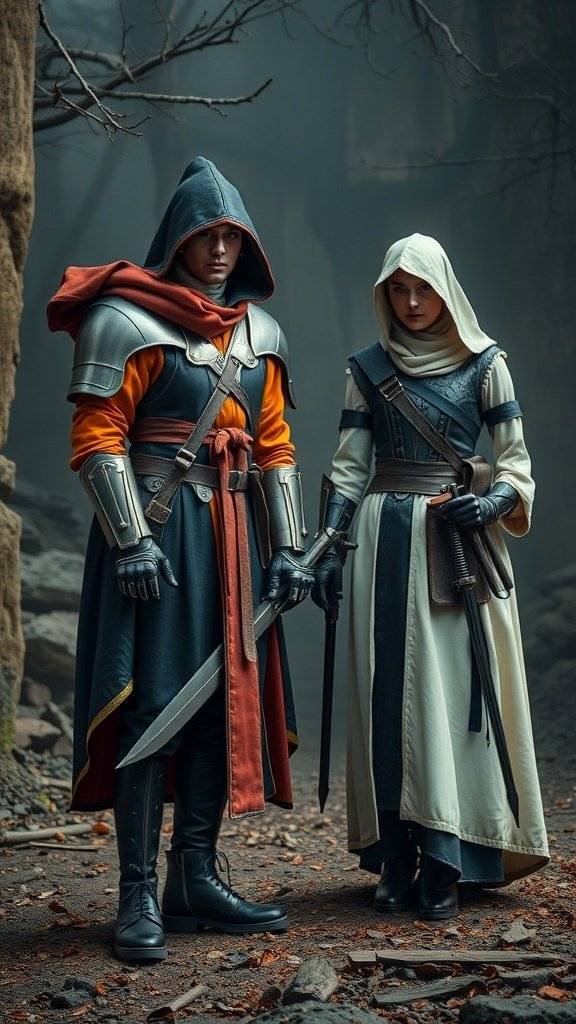
In the realm of Medieval Revivalism, the blend of historical inspiration and modern aesthetics creates a unique style. The image captures two figures dressed in outfits that reflect this fusion. Their attire features elements reminiscent of the 14th and 15th centuries, yet with a futuristic twist.
The first figure sports a striking ensemble with layered textures and a hood, combining traditional armor with a contemporary flair. The vibrant orange underlayer adds a pop of color, while the metallic accents give a nod to modern design. The second figure complements this look with a flowing gown that maintains the medieval silhouette but incorporates sleek lines and a minimalist approach.
This blend of styles showcases how medieval influences can be reimagined for today’s fashion. The use of swords hints at a narrative, suggesting a story that intertwines the past with the future. Such outfits not only celebrate history but also inspire creativity in modern wardrobe choices.
Regal Gowns with Rich Embellishments
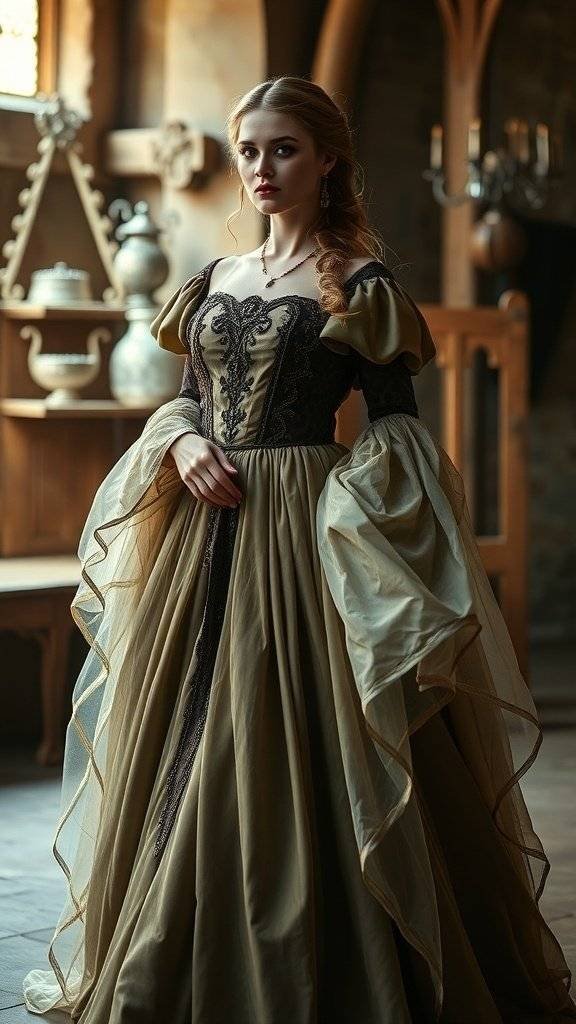
In the realm of Medieval Revivalism, regal gowns take center stage, showcasing the beauty and craftsmanship of the 14th and 15th centuries. The image captures a stunning gown that embodies this era’s elegance. The rich colors and intricate details draw the eye, making it a perfect representation of the time.
The gown features a fitted bodice adorned with delicate embroidery, which highlights the wearer’s silhouette. The flowing skirt cascades gracefully, creating a sense of movement. The sleeves are particularly noteworthy, with their dramatic, billowing design adding a touch of grandeur.
Accessories play a key role in enhancing the overall look. A simple necklace complements the gown without overshadowing its beauty. This balance is essential in achieving a regal appearance that feels both authentic and modern.
Such outfits not only celebrate the artistry of the past but also inspire contemporary fashion. Whether for a themed event or a creative photoshoot, these gowns offer a glimpse into a world where elegance and craftsmanship reign supreme.
Elegant Corsetry and Historical Tailoring
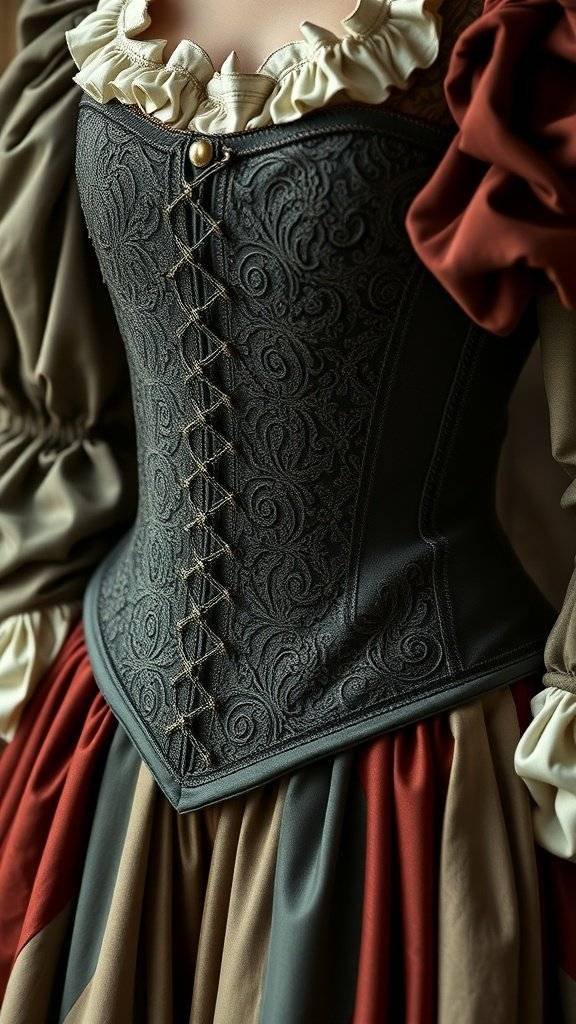
The image showcases a beautifully crafted corset that embodies the spirit of Medieval Revivalism. The intricate patterns on the fabric highlight the attention to detail that was common in the 14th and 15th centuries. This corset is not just a piece of clothing; it represents a blend of artistry and functionality.
Flowing from the corset are layers of fabric that create a stunning silhouette. The combination of rich colors and textures brings to mind the opulence of medieval attire. The ruffled neckline adds a touch of softness, balancing the structured form of the corset.
Historical tailoring techniques are evident in the way the corset is designed. The lacing and stitching reflect the craftsmanship that went into making garments during this period. Each element tells a story, connecting modern fashion to its historical roots.
Wearing such outfits today allows individuals to embrace a piece of history while expressing their unique style. The revival of these medieval elements in contemporary fashion is a celebration of heritage and creativity.
You may also like:
– 17 Glamorous Makeup Ideas Inspired by the Roaring 1920s
– 18 Retro Men’s Casual Fashion Ideas Inspired by the 1960s
– 24 Stunning Evening Dresses Inspired by Game of Thrones
If you enjoyed this blog you can visit us or check out our other blogs and learn a bit about us.
Disclaimer: This blog post is inspired by fictional universes and characters created by their respective rights holders. All related content and imagery remain the property of their respective rights holder. This fan-inspired content is for entertainment and commentary purposes only and is not affiliated with or endorsed by HBO, Disney, Warner Bros., Lionsgate, or any other rights holders. To explore the official source material, please visit:
HBO

